- 7 Super and Strategic Hooks In Speaking
- Uncategorized >>

Recent speech at an education conference to 500 educators but many more showed up!
If you don’t have hooks strategically sprinkled throughout your speech, chances are your audience will bail mentally if not physically.
You have to find ways to keep hooking your audience so THEY don’t want to let go.
Below you’ll find 7 super hooks (in no particular order) that get your audience to say, “Tell me more” or “What happened next?”

Hook #1: Curiosity Hook
“After 15 years of trial and error, research, and blood, sweat, and tears, I’ve finally found out what makes the difference between a good presenter and a great one. It’s…”
That’s an example of a curiosity hook. You find ways to make your long road lead to their shortcut. However, you don’t tell them what they want to know…at least not immediately. Make them curious, tease them a little more, and then give them the tool (or solution, answer, or formula, etc.).
Hook #2 – Avoidance Hook
Here’s an example of an Avoidance Hook.
I tell a story about a speech I gave in Michigan when I failed miserably to the point where the meeting planner couldn’t even look me in the eyes. Then I say to my audience of speakers, “This is something you should not have to go through and you won’t if you listen closely.”
The Avoidance Hook focuses on something your audience wants to avoid. It’s important to use this type of hook because sometimes people are motivated by what they want to avoid more than they are by what they want to attain.
Hook #3 – Attainment Hook
I’ve said to an audience of speakers, “How would you like a tool to make a deeper connection than you’ve ever made before? If so, say yes.” They always yell, “YES!”
The Attainment Hook is just how it sounds. You simply let the audience know what they can attain if they pay attention to what’s coming next. Think results-based. I mention that they’ll be able to make a deeper connection than they ever have before. That’s certainly something they want, but I make sure to tease them before I tell them. Don’t give it up too soon. Make them wait for it and want it.
Hook #4 The “Most People” Hook
When speaking, always keep this in mind:
Most people don’t want to be most people”
When I used to watch the master presenters, I realized many of them made statements like, “Most people do this” or “Most people do that.” Whenever I heard those statements, I’d say to myself “I’m not going to be like most people. I don’t want to be average. I want to do something different.”
That’s the effect the words “most people” have on people. For example, I’ve said, “Most people live their lives on get-set. When it comes to pursuing their goals and dreams, they take their marks, they get-set, and they never go. They live and they die on get-set.”
Because “most people” are two of the most persuasive words in the English language, my audience members get very motivated to “go” rather than live on “get-set.”
Hook #5 – Conflict Hook
Good stories have a conflict that is established early. Great stories not only establish the conflict, they also escalate it. Think about the Titanic. One of the conflicts was when the Titanic hit the iceberg. However, the escalation of the conflict was when the water rose on the Titanic. If the water never rose on the Titanic, then that would have been a terrible movie. Always think, “How can I raise the water on the Titanic in my story?”
The conflict is the hook because your audience wants to see how you will overcome it and what tools you will use. Why? Because maybe they can use similar tools for similar situations. In that way, your speech has become very useful to them.
Hook #6 Silence Hook
I tell a story about how excited I was to meet my speaking hero. The only problem was, when I approached him, he said nothing back to me. That silence in the story becomes a hook because my audience is anxious to hear what he is going to say and then, when he doesn’t say anything, they get ever hungrier to see what I’m going to do about it. The silent moment becomes the hook.
The problem with some speakers is they rush through the silence and make the potential hook much less effective. Take your time, dance in the silence, and watch your audience move to the edge of their seats.
Hook #7 Statement Hook
One of the first stories I ever told as a speaker started out like this:
“Nobody has ever died from a snakebite.”
My audience wonders, “What’s he talking about? People get bitten all the time and I’m sure some of them have died.”
I then go on to tell them it’s not the bite, it’s the venom that kills them.
The key is that the first statement hooked them in to want to know more. The rest of the story cleared it up and answered their question.
When all of your hooks are done, your speech is over.
Final Words on Hooks
As you can see, it’s important not only to have hooks at the beginning and end of your speeches, but to sprinkle them throughout. Remember, when you are in speaking, you are in sales. These hooks will sell your audience on listening to the next part of your presentation.
Oh, wait a minute! I almost forgot. There is an 8 th hook and it’s more powerful than the other 7 combined. It’s…
- Recent Posts
- 4 Ways to Create an Experience and Get Your Audience Involved - April 4, 2024
- 3 Ways to Create Great Value for Your Audience - March 8, 2024
- Mastering Your Audience Connection – 3 Key Lessons - February 16, 2024
Leave a Reply 17 comments
Leave a reply:.
Save my name, email, and website in this browser for the next time I comment.
- AI Content Shield
- AI KW Research
- AI Assistant
- SEO Optimizer
- AI KW Clustering
- Customer reviews
- The NLO Revolution
- Press Center
- Help Center
- Content Resources
- Facebook Group
8 Effective Hooks to Start Your Speech
Table of Contents
Speeches can be challenging to communicate complicated or nuanced information, which is why the opening sentence matters so much. Hooks for speeches have the power to pull the listener in and keep them involved.
They will grab your audience’s attention, get them engaged and interested in what you say, and gradually help set the tone for your speech.
In this article, you’ll find eight effective ways to hook your audience and start a strong presentation.
What Is a Hook in Speech?
A hook is a tool to show your audience where you are going in your speech. They are used in two different ways. Firstly, they are used as a transition between ideas. Secondly, Hooks are used to keep the audience involved and engaged .
Using a hook can help keep your audience focused and give them something to hold on to while you get your point across. A good hook grabs the audience’s attention and gets them interested in what you’re saying.

8 Effective Hooks for Speeches
One way to start your speech is to hook your audience with a powerful way of describing the topic you are speaking on. Hooks can be as simple as descriptions, metaphors, or quotations. Here are eight hooks for speeches to make a lasting impression on the audience.
1. Take a Contrarian Stance
One way to start your speech with a powerful hook is to use a contrarian approach. This means that you take another stance on the issue and discuss it orally, thereby raising doubts in your audience.
One way to create a contrarian approach is to argue against an opinion or belief. A contrarian attitude can create easily recognizable hooks for a speech and succeed in catching the audience’s attention.
2. Ask Several Rhetorical Questions
Rhetorical questions are powerful because they pull at people’s heartstrings. They make statements and ask the listener to agree. Used wisely, they can lead the audience into an argument.
The goal of the question is to ask the listener to think and make a judgment on his own.
3. Use a Powerful Sound Bite
A sound bite is a brief statement that captures the attention of your audience and promises a thought-provoking result. It makes it easier to remember the specifics of what you are talking about.
For example, “Did you know that in 2016 each enterprise had a choice? The choice to go from silos and silences to voice and insight”?
4. Provide a Reference to a Historical Event
Mentioning a historical event is a good attention-getter for speeches. Sometimes you can use the day you present as an opening gambit to tie the topic of your presentation to some historical significance.
Whenever you reference historical events, the audience instantly associates them with their own experience. This leads to a higher level of interest.
5. Employ a Startling Assertion
Making a startling assertion is a quick and effective strategy to get attention. If you’re having trouble coming up with a hook, employ a striking fact. Spend some time researching shocking data that show how serious the topic you’re going to discuss is.
For example, “You might not know, but your brain has less than three seconds to react when you see a bear in the wild.” This is startling as people believe they have enough time to think about what will happen before a bear attack.
6. Take Them Through Imagine or What If Scenario
This is a great hook to start a persuasive speech or one that discusses possible scenarios. It’s an ideal hook for a premise based on hypothetical situations and the effects of potential changes.
Ask the audience something that might change their viewpoint, like what if you could go invisible for a day or go back in time? You can also use the word ‘Imagine’ to draw a mental image and engage the mind.
7. Use Quotations With Your Twist
The usage of quotations is a common strategy for hooks. Although many speakers begin with an appropriate quotation, you might stand out by reciting the quote and putting a twist. You might also use a quote from your personal experience.
8. Tell the Audience a Story
Starting a speech with a story is a great way to engage your audience. For example, “Remember the first time you had a conversation with a child, someone who hadn’t even been born yet? ”
Each of your listeners would probably remember this conversation vividly because they were a part of it. When starting a speech with a story, use an analogy or an experience to heighten the experience.
Make it relatable and better engage your audience.
Hooks are the rhetorical devices that help you to pull your audience in . There are many different hooks for speeches, and each one is effective in its way.
They help to create a dynamic and colorful tone that keeps the audience engaged. Remember that the audience will only give you about 30 seconds before deciding whether or not to continue listening.
Employ one of the eight effective hooks mentioned in this post to make your speech memorable for the audience.

Abir Ghenaiet
Abir is a data analyst and researcher. Among her interests are artificial intelligence, machine learning, and natural language processing. As a humanitarian and educator, she actively supports women in tech and promotes diversity.
Explore All Hook Writing Articles
Guide to writing an interesting expository essay introduction.
A good expository essay begins with an introduction that piques the interest of the reader. The expository essay introduction is…
- Hook Writing
Discover the Top Creative Story Introduction Examples
Are you an aspiring author dreaming of becoming the likes of Stephen King or Suzanne Collins? Would you like to…
Creative and Powerful Sentence Starters for Essays
It can’t be said enough, first impressions matter. And it goes the same for essays because your starter sentences will…
Most Important Parts of an Essay Introduction
The introduction is often one of the most important sections in a paper. It creates a sense of what the…
7 Effective Ways to Start a Sentence
There are different ways to start a sentence and convey your message effectively to the readers. Being aware of the…
Six Social Media Hooks to Boost Engagement
To get the most out of your marketing strategy, you should consider using social media hooks to improve your engagement…

How it works
Transform your enterprise with the scalable mindsets, skills, & behavior change that drive performance.
Explore how BetterUp connects to your core business systems.
We pair AI with the latest in human-centered coaching to drive powerful, lasting learning and behavior change.
Build leaders that accelerate team performance and engagement.
Unlock performance potential at scale with AI-powered curated growth journeys.
Build resilience, well-being and agility to drive performance across your entire enterprise.
Transform your business, starting with your sales leaders.
Unlock business impact from the top with executive coaching.
Foster a culture of inclusion and belonging.
Accelerate the performance and potential of your agencies and employees.
See how innovative organizations use BetterUp to build a thriving workforce.
Discover how BetterUp measurably impacts key business outcomes for organizations like yours.
A demo is the first step to transforming your business. Meet with us to develop a plan for attaining your goals.

- What is coaching?
Learn how 1:1 coaching works, who its for, and if it's right for you.
Accelerate your personal and professional growth with the expert guidance of a BetterUp Coach.
Types of Coaching
Navigate career transitions, accelerate your professional growth, and achieve your career goals with expert coaching.
Enhance your communication skills for better personal and professional relationships, with tailored coaching that focuses on your needs.
Find balance, resilience, and well-being in all areas of your life with holistic coaching designed to empower you.
Discover your perfect match : Take our 5-minute assessment and let us pair you with one of our top Coaches tailored just for you.

Research, expert insights, and resources to develop courageous leaders within your organization.
Best practices, research, and tools to fuel individual and business growth.
View on-demand BetterUp events and learn about upcoming live discussions.
The latest insights and ideas for building a high-performing workplace.
- BetterUp Briefing
The online magazine that helps you understand tomorrow's workforce trends, today.
Innovative research featured in peer-reviewed journals, press, and more.
Founded in 2022 to deepen the understanding of the intersection of well-being, purpose, and performance
We're on a mission to help everyone live with clarity, purpose, and passion.
Join us and create impactful change.
Read the buzz about BetterUp.
Meet the leadership that's passionate about empowering your workforce.

For Business
For Individuals
8 clever hooks for presentations (with tips)

Jump to section
What’s a good hook?
The importance of a good hook, 8 good hooks for speeches and presentations , leave a lasting impression.
When delivering a presentation, the first few minutes are crucial for capturing your audience’s attention. This is your chance to build intrigue around your topic and give listeners an idea of what’s to follow.
The best speakers use powerful hooks for presentations to introduce their topics, build suspense, and spark curiosity . These hooks are sharp and quick to grab attention — the kind that sticks around until the end of the presentation. They can be a surprising statistic, a thought-provoking question , and even a short personal story.
Drafting excellent hooks for presentations is essential to building anticipation and sowing the seeds for your audience’s growing interest. And with a limited window of opportunity to gain your listener’s interest and trust, your hook needs to be as substantial as the rest of your presentation.
A good hook introduces your subject matter , engages your audience, and sets the tone for the rest of the presentation.
Capturing listeners’ attention can be challenging as a presenter, especially if they’re attending out of obligation rather than individual interest. Although it’s wonderful to present to a room full of people eager to hear what you have to say, this won’t always be the case.
Knowing how to make a good hook can set you up for a successful presentation , no matter who’s in the audience. It engages listeners from the very beginning (and might even ignite a disinterested party’s curiosity).
Consider who your audience members are and what they want to learn. Their background should inform the tone of the presentation and lay the groundwork for building an angle.
When giving a presentation on ocean acidification to an environmental board, you could deliver a thought-provoking statistic on coral bleaching or provide a personal story that illustrates ecological changes that have taken place in your lifetime.
Remember: the hook should hint at the value your listeners will gain from your presentation without giving away too much too soon. Don’t spoil the plot twist, but make sure you start foreshadowing.
Impressions are formed quickly, making it crucial for the start of your presentation to kick off on a high note.
According to psychologist Alexander Todorov and researcher Janine Willis, it takes a tenth of a second to form an impression of a stranger . During this brief moment, we evaluate qualities such as likability and trustworthiness.
Although coming up with a hook idea that appeals to listeners within a tenth of a second may be impossible, your first few words are important. Knowing how quickly we form perceptions may be intimidating, but with the right intro, a short time frame can work in your favor.
A well-developed and intriguing hook gives your listeners a positive first impression and influences how they interpret the rest of the presentation.

The hook is a key opportunity to show why your topic is exciting or worth considering. Here are eight types of hooks and hook examples to stimulate your audience’s interest, no matter the subject.
1. Make a surprising claim
Starting your speech with a surprising statement or statistic is an excellent way to grab your listener’s attention. A person giving a presentation on the benefits of coaching services to a company’s top executives could share the increase in employee productivity that teams experience after implementing coaching in the workplace.
Example: “Productivity increases 63% in workplaces that provide employees with group coaching services.”
The trick to making a surprising claim? It needs to shock your audience. If you create a statistic-based hook, it must be substantial enough to be of value to your listeners and persuade them to learn more about your topic.
Imagine that the example above only referenced a 5% increase. The executives would likely view the number as too little to invest in coaching services, making them less eager to pay attention during the presentation.
2. Start with a story
Stories are an excellent way to enhance information retention, making them a great tool for leaving a lasting impression on your audience.
According to organizational psychologist Peg Neuhauser, we recall what we learned from a well-told story more accurately than we do from facts and figures . So, if there’s a piece of information you’d like to impart to your audience, consider wrapping it in a short but compelling narrative.
When selecting an anecdote to share, ensure it’s relevant to your topic and resonates with your audience. A story that excites a sales team will likely differ from what an engineering team finds compelling.
Example: When delivering a presentation on the benefits of sleep on mental clarity, the speaker provides a story from your personal experience . They describe a period when construction outside constantly interrupted their sleep and how that negatively impacted several areas of their life, including their career and relationships.
This story uses vulnerability to earn the audience’s trust and segues into the rest of the presentation: breaking down how deep sleep is vital to performing your best.

3. Reference a historical event
This extra creative spin on the storytelling hook relies on a fascinating historical moment rather than your personal experience. The odds that your audience understands the wider context and thus the relevance of your presentation makes historical references good attention grabbers.
A person giving a product pitch to potential investors could start with an anecdote about when they developed the first iteration of their product.
Example: “Did you know that jeans were invented 150 years ago? On an ordinary day like today, Levi Strauss and tailor Jacob Davis combined metal rivets and denim trousers to create durable work pants for gold rush miners.”
This historical hook creates a captivating opening for a pitch about stylish and wearable apparel. The speaker can lean on this historical reference to introduce a product that’s even more universal than jeans.
4. Ask an intriguing question
Finding a single starting sentence that hooks readers isn’t always easy. But incorporating participation into the start of your presentation is a fun way to hook your audience, even if it’s with a rhetorical question that encourages them to participate mentally.
Your question should be as captivating and intellectually stimulating as possible to pique the interest of each of your audience members. This approach works great for introducing products, services, or projects, as you can present what you’ve been working on as the answer to the question.
Example: “What if there was a way to fight the climate crisis while you cook dinner?”
Remember to pause after asking a question to give your audience time to brainstorm possible answers and stimulate their curiosity.
If you’re giving a business presentation, conduct research beforehand to ensure your question is relevant to your clients. The answer should mean something to your audience or solve a pain point they experience.
5. Contradict expectations
Contradicting a widely held belief is a compelling way to grab your listener’s attention. Do this by starting your presentation with a statement that challenges your audience’s presumptions.
Example: “Hydration isn’t all about how much water you drink.”
This presentation hook intrigues audience members to learn what else is needed other than water to stay hydrated. You can then lead your presentation through several methods for staying hydrated , like incorporating electrolytes into your diet and eating fruits and vegetables with high water content.
6. Show a captivating video
Starting your presentation with a video allows someone else to break the ice for you. Choose a short video related to your topic that easily transitions into your slideshow.
Example: A graphic design team manager wants to introduce new software into their department. They show a video from the product designers that provides an in-depth and visually engaging overview of the software’s features and benefits.
After the video ends, the speaker can move on to slides that describe how the team can leverage the software to improve their workflow and creative outputs.
7. Use a quote from a famous figure
Find a quote from someone admirable that relates to your presentation and impart wisdom to your audience.
Example: Someone’s administering a presentation on professional networking. They use Maya Angelou’s famous quote, “I’ve learned that people will forget what you said, people will forget what you did, but people will never forget how you made them feel.”
Although this quote can apply to a number of topics, in a networking context , it emphasizes how important it is for people to consider how they make others feel when they first meet. This tells your audience that a critical networking component is connecting with others personally rather than focusing solely on what they do professionally.
8. Show an object
An object can promote interaction and help your audience visualize what you’re talking about. This is especially helpful if you’re pitching a product and want to show listeners what the product looks like in real life and how it functions.
Example: A salesperson presents a new lamp design to a furniture store. They enhance the pitch by bringing the lamp to the presentation and demonstrating its ambient light features.
This strategy also works in contexts when you’re discussing the gravity of a statistic. For instance, if you’re aiming to communicate the dire levels of microplastics in the ocean, you could illustrate the severity by showing the audience a container filled with plastic fragments.

It’s not always easy to grab your listener’s attention when speaking publicly. Using hooks for presentations is one of the most effective ways to fan your audience’s curiosity and earn their engagement from start to finish.
The key is to keep your hook brief, relevant, and engaging. Remember to take the time to know your audience and set up your presentation to deliver valuable information from the start.
Elevate your communication skills
Unlock the power of clear and persuasive communication. Our coaches can guide you to build strong relationships and succeed in both personal and professional life.
Elizabeth Perry, ACC
Elizabeth Perry is a Coach Community Manager at BetterUp. She uses strategic engagement strategies to cultivate a learning community across a global network of Coaches through in-person and virtual experiences, technology-enabled platforms, and strategic coaching industry partnerships. With over 3 years of coaching experience and a certification in transformative leadership and life coaching from Sofia University, Elizabeth leverages transpersonal psychology expertise to help coaches and clients gain awareness of their behavioral and thought patterns, discover their purpose and passions, and elevate their potential. She is a lifelong student of psychology, personal growth, and human potential as well as an ICF-certified ACC transpersonal life and leadership Coach.
The 10 best work productivity tools to maximize your time
How to make a to-do list that simplifies your life, 18 excellent educational podcasts to fuel your love of learning, 9 project management (pm) tools that help you get the job done, what is lateral thinking 7 techniques to encourage creative ideas, squirrel how to increase attention span so you get stuff done, 17 top apps to help you focus in the digital age, learn how to manage two jobs at once, 10 journaling apps to turn today into a better tomorrow, similar articles, how to write a speech that your audience remembers, the importance of good speech: 5 tips to be more articulate, how to pitch ideas: 8 tips to captivate any audience, the 11 tips that will improve your public speaking skills, your guide to what storytelling is and how to be a good storyteller, how to make vacation mindset last all year long, how the minto pyramid principle can enhance your communication skills, 9 elevator pitch examples for making a strong first impression, how to make a presentation interactive and exciting, stay connected with betterup, get our newsletter, event invites, plus product insights and research..
3100 E 5th Street, Suite 350 Austin, TX 78702
- Platform Overview
- Integrations
- Powered by AI
- BetterUp Lead
- BetterUp Manage™
- BetterUp Care™
- Sales Performance
- Diversity & Inclusion
- Case Studies
- Why BetterUp?
- About Coaching
- Find your Coach
- Career Coaching
- Communication Coaching
- Life Coaching
- News and Press
- Leadership Team
- Become a BetterUp Coach
- BetterUp Labs
- Center for Purpose & Performance
- Leadership Training
- Business Coaching
- Contact Support
- Contact Sales
- Privacy Policy
- Acceptable Use Policy
- Trust & Security
- Cookie Preferences
15 Powerful Speech Opening Lines (And How to Create Your Own)
Hrideep barot.
- Public Speaking , Speech Writing

Powerful speech opening lines set the tone and mood of your speech. It’s what grips the audience to want to know more about the rest of your talk.
The first few seconds are critical. It’s when you have maximum attention of the audience. And you must capitalize on that!
Instead of starting off with something plain and obvious such as a ‘Thank you’ or ‘Good Morning’, there’s so much more you can do for a powerful speech opening (here’s a great article we wrote a while ago on how you should NOT start your speech ).
To help you with this, I’ve compiled some of my favourite openings from various speakers. These speakers have gone on to deliver TED talks , win international Toastmaster competitions or are just noteworthy people who have mastered the art of communication.
After each speaker’s opening line, I have added how you can include their style of opening into your own speech. Understanding how these great speakers do it will certainly give you an idea to create your own speech opening line which will grip the audience from the outset!
Alright! Let’s dive into the 15 powerful speech openings…
Note: Want to take your communications skills to the next level? Book a complimentary consultation with one of our expert communication coaches. We’ll look under the hood of your hurdles and pick two to three growth opportunities so you can speak with impact!
1. Ric Elias
Opening: “Imagine a big explosion as you climb through 3,000 ft. Imagine a plane full of smoke. Imagine an engine going clack, clack, clack. It sounds scary. Well I had a unique seat that day. I was sitting in 1D.”
How to use the power of imagination to open your speech?
Putting your audience in a state of imagination can work extremely well to captivate them for the remainder of your talk.
It really helps to bring your audience in a certain mood that preps them for what’s about to come next. Speakers have used this with high effectiveness by transporting their audience into an imaginary land to help prove their point.
When Ric Elias opened his speech, the detail he used (3000 ft, sound of the engine going clack-clack-clack) made me feel that I too was in the plane. He was trying to make the audience experience what he was feeling – and, at least in my opinion, he did.
When using the imagination opening for speeches, the key is – detail. While we want the audience to wander into imagination, we want them to wander off to the image that we want to create for them. So, detail out your scenario if you’re going to use this technique.
Make your audience feel like they too are in the same circumstance as you were when you were in that particular situation.
2. Barack Obama
Opening: “You can’t say it, but you know it’s true.”
3. Seth MacFarlane
Opening: “There’s nowhere I would rather be on a day like this than around all this electoral equipment.” (It was raining)
How to use humour to open your speech?
When you use humour in a manner that suits your personality, it can set you up for a great speech. Why? Because getting a laugh in the first 30 seconds or so is a great way to quickly get the audience to like you.
And when they like you, they are much more likely to listen to and believe in your ideas.
Obama effortlessly uses his opening line to entice laughter among the audience. He brilliantly used the setting (the context of Trump becoming President) and said a line that completely matched his style of speaking.
Saying a joke without really saying a joke and getting people to laugh requires you to be completely comfortable in your own skin. And that’s not easy for many people (me being one of them).
If the joke doesn’t land as expected, it could lead to a rocky start.
Keep in mind the following when attempting to deliver a funny introduction:
- Know your audience: Make sure your audience gets the context of the joke (if it’s an inside joke among the members you’re speaking to, that’s even better!). You can read this article we wrote where we give you tips on how you can actually get to know your audience better to ensure maximum impact with your speech openings
- The joke should suit your natural personality. Don’t make it look forced or it won’t elicit the desired response
- Test the opening out on a few people who match your real audience. Analyze their response and tweak the joke accordingly if necessary
- Starting your speech with humour means your setting the tone of your speech. It would make sense to have a few more jokes sprinkled around the rest of the speech as well as the audience might be expecting the same from you
4. Mohammed Qahtani
Opening: Puts a cigarette on his lips, lights a lighter, stops just before lighting the cigarette. Looks at audience, “What?”
5. Darren Tay
Opening: Puts a white pair of briefs over his pants.
How to use props to begin your speech?
The reason props work so well in a talk is because in most cases the audience is not expecting anything more than just talking. So when a speaker pulls out an object that is unusual, everyone’s attention goes right to it.
It makes you wonder why that prop is being used in this particular speech.
The key word here is unusual . To grip the audience’s attention at the beginning of the speech, the prop being used should be something that the audience would never expect. Otherwise, it just becomes something that is common. And common = boring!
What Mohammed Qahtani and Darren Tay did superbly well in their talks was that they used props that nobody expected them to.
By pulling out a cigarette and lighter or a white pair of underwear, the audience can’t help but be gripped by what the speaker is about to do next. And that makes for a powerful speech opening.
6. Simon Sinek
Opening: “How do you explain when things don’t go as we assume? Or better, how do you explain when others are able to achieve things that seem to defy all of the assumptions?”
7. Julian Treasure
Opening: “The human voice. It’s the instrument we all play. It’s the most powerful sound in the world. Probably the only one that can start a war or say “I love you.” And yet many people have the experience that when they speak people don’t listen to them. Why is that? How can we speak powerfully to make change in the world?”
How to use questions to open a speech?
I use this method often. Starting off with a question is the simplest way to start your speech in a manner that immediately engages the audience.
But we should keep our questions compelling as opposed to something that is fairly obvious.
I’ve heard many speakers start their speeches with questions like “How many of us want to be successful?”
No one is going to say ‘no’ to that and frankly, I just feel silly raising my hand at such questions.
Simon Sinek and Jullian Treasure used questions in a manner that really made the audience think and make them curious to find out what the answer to that question is.
What Jullian Treasure did even better was the use of a few statements which built up to his question. This made the question even more compelling and set the theme for what the rest of his talk would be about.
So think of what question you can ask in your speech that will:
- Set the theme for the remainder of your speech
- Not be something that is fairly obvious
- Be compelling enough so that the audience will actually want to know what the answer to that question will be
8. Aaron Beverley
Opening: Long pause (after an absurdly long introduction of a 57-word speech title). “Be honest. You enjoyed that, didn’t you?”
How to use silence for speech openings?
The reason this speech opening stands out is because of the fact that the title itself is 57 words long. The audience was already hilariously intrigued by what was going to come next.
But what’s so gripping here is the way Aaron holds the crowd’s suspense by…doing nothing. For about 10 to 12 seconds he did nothing but stand and look at the audience. Everyone quietened down. He then broke this silence by a humorous remark that brought the audience laughing down again.
When going on to open your speech, besides focusing on building a killer opening sentence, how about just being silent?
It’s important to keep in mind that the point of having a strong opening is so that the audience’s attention is all on you and are intrigued enough to want to listen to the rest of your speech.
Silence is a great way to do that. When you get on the stage, just pause for a few seconds (about 3 to 5 seconds) and just look at the crowd. Let the audience and yourself settle in to the fact that the spotlight is now on you.
I can’t put my finger on it, but there is something about starting the speech off with a pure pause that just makes the beginning so much more powerful. It adds credibility to you as a speaker as well, making you look more comfortable and confident on stage.
If you want to know more about the power of pausing in public speaking , check out this post we wrote. It will give you a deeper insight into the importance of pausing and how you can harness it for your own speeches. You can also check out this video to know more about Pausing for Public Speaking:
9. Dan Pink
Opening: “I need to make a confession at the outset here. Little over 20 years ago, I did something that I regret. Something that I’m not particularly proud of. Something that in many ways I wish no one would ever know but that here I feel kind of obliged to reveal.”
10. Kelly McGonigal
Opening: “I have a confession to make. But first I want you to make a little confession to me.”
How to use a build-up to open your speech?
When there are so many amazing ways to start a speech and grip an audience from the outset, why would you ever choose to begin your speech with a ‘Good morning?’.
That’s what I love about build-ups. They set the mood for something awesome that’s about to come in that the audience will feel like they just have to know about.
Instead of starting a speech as it is, see if you can add some build-up to your beginning itself. For instance, in Kelly McGonigal’s speech, she could have started off with the question of stress itself (which she eventually moves on to in her speech). It’s not a bad way to start the speech.
But by adding the statement of “I have a confession to make” and then not revealing the confession for a little bit, the audience is gripped to know what she’s about to do next and find out what indeed is her confession.
11. Tim Urban
Opening: “So in college, I was a government major. Which means that I had to write a lot of papers. Now when a normal student writes a paper, they might spread the work out a little like this.”
12. Scott Dinsmore
Opening: “8 years ago, I got the worst career advice of my life.”
How to use storytelling as a speech opening?
“The most powerful person in the world is the storyteller.” Steve Jobs
Storytelling is the foundation of good speeches. Starting your speech with a story is a great way to grip the audience’s attention. It makes them yearn to want to know how the rest of the story is going to pan out.
Tim Urban starts off his speech with a story dating back to his college days. His use of slides is masterful and something we all can learn from. But while his story sounds simple, it does the job of intriguing the audience to want to know more.
As soon as I heard the opening lines, I thought to myself “If normal students write their paper in a certain manner, how does Tim write his papers?”
Combine such a simple yet intriguing opening with comedic slides, and you’ve got yourself a pretty gripping speech.
Scott Dismore’s statement has a similar impact. However, just a side note, Scott Dismore actually started his speech with “Wow, what an honour.”
I would advise to not start your talk with something such as that. It’s way too common and does not do the job an opening must, which is to grip your audience and set the tone for what’s coming.
13. Larry Smith
Opening: “I want to discuss with you this afternoon why you’re going to fail to have a great career.”
14. Jane McGonigal
Opening: “You will live 7.5 minutes longer than you would have otherwise, just because you watched this talk.”
How to use provocative statements to start your speech?
Making a provocative statement creates a keen desire among the audience to want to know more about what you have to say. It immediately brings everyone into attention.
Larry Smith did just that by making his opening statement surprising, lightly humorous, and above all – fearful. These elements lead to an opening statement which creates so much curiosity among the audience that they need to know how your speech pans out.
This one time, I remember seeing a speaker start a speech with, “Last week, my best friend committed suicide.” The entire crowd was gripped. Everyone could feel the tension in the room.
They were just waiting for the speaker to continue to know where this speech will go.
That’s what a hard-hitting statement does, it intrigues your audience so much that they can’t wait to hear more! Just a tip, if you do start off with a provocative, hard-hitting statement, make sure you pause for a moment after saying it.
Silence after an impactful statement will allow your message to really sink in with the audience.
Related article: 5 Ways to Grab Your Audience’s Attention When You’re Losing it!
15. Ramona J Smith
Opening: In a boxing stance, “Life would sometimes feel like a fight. The punches, jabs and hooks will come in the form of challenges, obstacles and failures. Yet if you stay in the ring and learn from those past fights, at the end of each round, you’ll be still standing.”
How to use your full body to grip the audience at the beginning of your speech?
In a talk, the audience is expecting you to do just that – talk. But when you enter the stage and start putting your full body into use in a way that the audience does not expect, it grabs their attention.
Body language is critical when it comes to public speaking. Hand gestures, stage movement, facial expressions are all things that need to be paid attention to while you’re speaking on stage. But that’s not I’m talking about here.
Here, I’m referring to a unique use of the body that grips the audience, like how Ramona did. By using her body to get into a boxing stance, imitating punches, jabs and hooks with her arms while talking – that’s what got the audience’s attention.
The reason I say this is so powerful is because if you take Ramona’s speech and remove the body usage from her opening, the entire magic of the opening falls flat.
While the content is definitely strong, without those movements, she would not have captured the audience’s attention as beautifully as she did with the use of her body.
So if you have a speech opening that seems slightly dull, see if you can add some body movement to it.
If your speech starts with a story of someone running, actually act out the running. If your speech starts with a story of someone reading, actually act out the reading.
It will make your speech opening that much more impactful.
Related article: 5 Body Language Tips to Command the Stage
Level up your public speaking in 15 minutes!
Get the exclusive Masterclass video delivered to your inbox to see immediate speaking results.
You have successfully joined our subscriber list.
Final Words
So there it is! 15 speech openings from some of my favourite speeches. Hopefully, these will act as a guide for you to create your own opening which is super impactful and sets you off on the path to becoming a powerful public speaker!
But remember, while a speech opening is super important, it’s just part of an overall structure.
If you’re serious about not just creating a great speech opening but to improve your public speaking at an overall level, I would highly recommend you to check out this course: Acumen Presents: Chris Anderson on Public Speaking on Udemy. Not only does it have specific lectures on starting and ending a speech, but it also offers an in-depth guide into all the nuances of public speaking.
Being the founder of TED Talks, Chris Anderson provides numerous examples of the best TED speakers to give us a very practical way of overcoming stage fear and delivering a speech that people will remember. His course has helped me personally and I would definitely recommend it to anyone looking to learn public speaking.
No one is ever “done” learning public speaking. It’s a continuous process and you can always get better. Keep learning, keep conquering and keep being awesome!
Lastly, if you want to know how you should NOT open your speech, we’ve got a video for you:
Enroll in our transformative 1:1 Coaching Program
Schedule a call with our expert communication coach to know if this program would be the right fit for you

8 Ways to Rise Above the Noise to Communicate Better

How to Negotiate: The Art of Getting What You Want

10 Hand Gestures That Will Make You More Confident and Efficient

- [email protected]
- +91 98203 57888
Get our latest tips and tricks in your inbox always
Copyright © 2023 Frantically Speaking All rights reserved
Kindly drop your contact details so that we can arrange call back
Select Country Afghanistan Albania Algeria AmericanSamoa Andorra Angola Anguilla Antigua and Barbuda Argentina Armenia Aruba Australia Austria Azerbaijan Bahamas Bahrain Bangladesh Barbados Belarus Belgium Belize Benin Bermuda Bhutan Bosnia and Herzegovina Botswana Brazil British Indian Ocean Territory Bulgaria Burkina Faso Burundi Cambodia Cameroon Canada Cape Verde Cayman Islands Central African Republic Chad Chile China Christmas Island Colombia Comoros Congo Cook Islands Costa Rica Croatia Cuba Cyprus Czech Republic Denmark Djibouti Dominica Dominican Republic Ecuador Egypt El Salvador Equatorial Guinea Eritrea Estonia Ethiopia Faroe Islands Fiji Finland France French Guiana French Polynesia Gabon Gambia Georgia Germany Ghana Gibraltar Greece Greenland Grenada Guadeloupe Guam Guatemala Guinea Guinea-Bissau Guyana Haiti Honduras Hungary Iceland India Indonesia Iraq Ireland Israel Italy Jamaica Japan Jordan Kazakhstan Kenya Kiribati Kuwait Kyrgyzstan Latvia Lebanon Lesotho Liberia Liechtenstein Lithuania Luxembourg Madagascar Malawi Malaysia Maldives Mali Malta Marshall Islands Martinique Mauritania Mauritius Mayotte Mexico Monaco Mongolia Montenegro Montserrat Morocco Myanmar Namibia Nauru Nepal Netherlands Netherlands Antilles New Caledonia New Zealand Nicaragua Niger Nigeria Niue Norfolk Island Northern Mariana Islands Norway Oman Pakistan Palau Panama Papua New Guinea Paraguay Peru Philippines Poland Portugal Puerto Rico Qatar Romania Rwanda Samoa San Marino Saudi Arabia Senegal Serbia Seychelles Sierra Leone Singapore Slovakia Slovenia Solomon Islands South Africa South Georgia and the South Sandwich Islands Spain Sri Lanka Sudan Suriname Swaziland Sweden Switzerland Tajikistan Thailand Togo Tokelau Tonga Trinidad and Tobago Tunisia Turkey Turkmenistan Turks and Caicos Islands Tuvalu Uganda Ukraine United Arab Emirates United Kingdom United States Uruguay Uzbekistan Vanuatu Wallis and Futuna Yemen Zambia Zimbabwe land Islands Antarctica Bolivia, Plurinational State of Brunei Darussalam Cocos (Keeling) Islands Congo, The Democratic Republic of the Cote d'Ivoire Falkland Islands (Malvinas) Guernsey Holy See (Vatican City State) Hong Kong Iran, Islamic Republic of Isle of Man Jersey Korea, Democratic People's Republic of Korea, Republic of Lao People's Democratic Republic Libyan Arab Jamahiriya Macao Macedonia, The Former Yugoslav Republic of Micronesia, Federated States of Moldova, Republic of Mozambique Palestinian Territory, Occupied Pitcairn Réunion Russia Saint Barthélemy Saint Helena, Ascension and Tristan Da Cunha Saint Kitts and Nevis Saint Lucia Saint Martin Saint Pierre and Miquelon Saint Vincent and the Grenadines Sao Tome and Principe Somalia Svalbard and Jan Mayen Syrian Arab Republic Taiwan, Province of China Tanzania, United Republic of Timor-Leste Venezuela, Bolivarian Republic of Viet Nam Virgin Islands, British Virgin Islands, U.S.

- Theater-Based Techniques
- Dr. Gary Genard
- What Our Clients Say
- Client List
- Dr. Genard in the Media
- Leadership Communication
- Fearless Speaking
- Voice and Speech Improvement
- Presentation Coaching
- Speaking Virtually
- Presentation Skills
- Executive Speech Coaching
- The Benefits of Deep Breathing
- How to Calm Your Nerves Before Speaking
- Leadership Skills: The 5 Essential Speaking Techniques
- 5 Ways to Captivate an Audience
- The Body Language Rules: 12 Ways to be a More Powerful Speaker
- 4 Characteristics of an Influential Speaker
- 6 Skills Building Exercises for Effective Body Language
- 7 Tips for Overcoming Audience Resistance
- 5 Rules for Succeeding with PowerPoint
- Great Speaking? – It's About Performance Over Content!
- 5 Key Tools of Vocal Dynamics
- 5 Secrets of Powerful Body Language
- 10 Ways to Stay Fully Focused when Speaking
- 25 Words or Phrases to Avoid in Speeches and Presentations
- 6 Rules of Effective Public Speaking
- 7 Key Components of Successful Presentations
- 12 Easy Ways to Achieve Presence and Charisma
- 6 Skills Building Exercises Video
Gary Genard's
Speak for success.
"Be a voice not an echo." - Albert Einstein
How to Hook Your Audience with An Effective Opening

Want to grab your presentation audience's attention immediately? Here's how to hook your audience with an effective opening.
"I speak to you for the first time as Prime Minister in a solemn hour for the life of our country, of our empire, of our allies, and, above all, of the cause of Freedom."
That's Winston Churchill, in his first broadcast speech as Prime Minister on May 19, 1940. Most of us don't have a topic as momentous as the "tremendous battle raging in France and Flanders" to speak about—or oratorical talent as great as Churchill's. But we have just as much need to hook our audiences at the start of our speeches and presentations.
Interested in the best presentation tips? Discover 101 tips for great public speaking! Get my Public Speaking Handbook, How to Give a Speech . Click on image below for more.
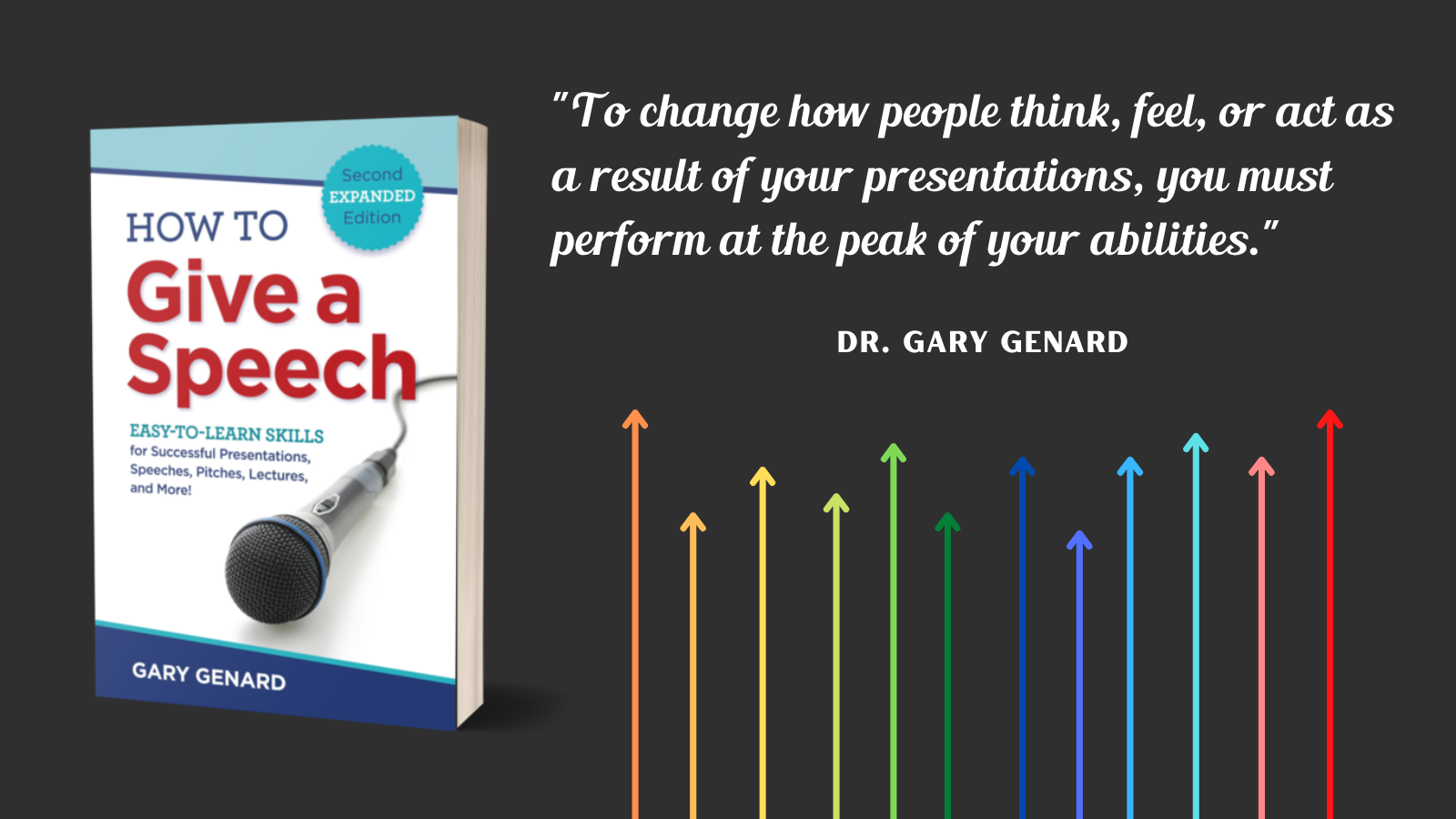
So, how are you doing in this department? The success of your talk depends upon your getting listeners to get engaged and stay that way . That's what a speech "hook" or "grabber" is designed to do.
What Is a Speech Hook and How Does It Work?
A hook or grabber is the part of your presentation that compels an audience to sit up and pay attention. It should come at the very beginning of your talk, where it can do the most good. Audiences have a lot on their minds as they prepare to listen to your remarks. They might in fact be attending a number of presentations during that week. So you need to let them know right away that you're the speaker who is going to be interesting.
Do you know the best practices for doing that? Discover how to motivate, inspire, and activate people! Get my Free Guide , "Six Rules of Effective Public Speaking."
Once engaged, listeners will stay with you. As long, that is, as the body of your speech lives up to the expectation you've created in your opening. But it's that hook that gets everything started.
An Effective vs. Ineffective Opening
To grasp the difference between an opening that hooks your listeners, and one that lets them get away, consider the following two speech openings. They're both from TED talks, and both are delivered by scientists. Which one grabs your attention?
(A) "We're going to go on a dive to the deep sea."
(B) "I study ants . . . in the desert, in the tropical forest, in my kitchen, and in the hills around Silicon Valley, where I live."
Is this starting to sound like a formula for speaking success? It is! To learn more, download my Free resource , "How to Start a Speech: 12 Foolproof Ways to Grab Your Audience."
I'll bet it's the first one. Who wouldn't want to go on a virtual dive with oceanographer David Gallo to explore the ocean depths (choice A)? It's nice that biologist Deborah Gordon studies ants (choice B). But it doesn't sound compelling.
In fact her topic—the link between ants, the human brain, and cancer—is fascinating. But her opening keeps her speech firmly tied to the earth. Like every speech, however, it needs to get airborne right off the launch pad.
Want to improve your "audience connecting" skills to start out with a bang? Download my Free resource , "How to Begin a Presentation: The Critical First 60 Seconds."
You Can Be Creative, Can't You?
So how can you make the Big Bang happen in your own speeches and presentations? Here are four key elements of a successful speech hook, along with examples. Remember, a hook should occur as early in your speech as possible. What, then, does a good speech hook do?
(1) It resonates with the audience.
If your topic happens to be of general interest to everyone, this requirement should be easy. Sir Ken Robinson , for instance, pulls it off in just nine seconds in his TED talk, "Do Schools Kill Creativity?"
Here's his opening, referring to the previous speakers at the event: "It's been great, hasn't it? I've been blown away by the whole thing. In fact . . . I'm leaving." Humor delivered well is always a winner. Equally successful is an opening that has special relevance to listeners. If you know your industry and your audience, you should be able to come up with a hook that absolutely resonates in this way.
(2) It surprises them.
Have you ever groaned inwardly because a speaker began, "My topic today is . . . "? How differently we react to an opening that's original! That's the speaker would will delight rather than bore us. Someone who knows how to do that is Gavin Pretor-Pinney in his TED Talk. He starts out: "Clouds ... have you ever noticed how much people moan about them?" If I mention the talk is titled "Cloudy with a Chance of Joy," you'll understand his surprising yet logical choice for his opening.
(3) It's concise.
You want impact. You may tell a great story, but its effect will evaporate if it goes on too long. Always consider the total time you have and craft an opening that helps balance the talk as a whole. Mark Twain once began a speech following a toast to the New England weather by saying, "I reverently believe that the Maker who made us all makes everything in New England but the weather." (I bet that opening surprised his listeners, too.)
(4) It taps into something larger than your topic.
Remember, your topic is your doorway to a place where you help change the world of your listeners. No speaker understood this better than President John F. Kennedy in 1961, when he said in the opening of his inaugural speech: "We observe today not a victory of party, but a celebration of freedom."
And here's the unmatched simplicity and understatement (and mischief) of Sojourner Truth's opening in her 1851 speech on women's rights, "Ain't I a Woman," which reflects on that issue as well as the other great one of the day: slavery: "Well, children, where there is so much racket there must be something out of kilter."
Resonant, surprising, concise, and connected with a much larger issue. Take away that lesson to help change your own world—one speech, and one speech hook, at a time.
This article was originally published in 2016. It is updated here.
You should follow me on Twitter here .

Tags: speeches , how to open a presentation , how to begin a presentation , how to start a speech , speech format , how to open a speech , how to organize a presentation , speech hook , how to hook an audience , how to organize a speech , how to start a presentation , speech hooks , speech grabbers , how to begin a speech , speech introduction examples , hook , opening , effective opening , how to capture an audience's attention , effective speech openings , grabber , how to grab your audience , how to get your audience's attention , how to capture people's attention , speech opening , speech openings , great speech openings
Subscribe to the blog
Follow gary genard.

- Training Techniques
Main Office - Boston
[email protected] 617-993-3410
- Executive Presentation Skills
- Rehearsal & Preparation
- Group Presentation Skills


- Audience , Structure
Six ways to hook the audience from the beginning
- January 17, 2021

Plato said, “The beginning is the most important part of the work.” When it comes to speeches and presentations, your beginning is critical. You get one chance to make a good first impression, so you want to hook the audience with your opening words.
An audience’s attention is usually at its highest just before you begin. There is hope and expectation in the air. You want to open in such a way as to capitalize on the this positive atmosphere and draw people irresistibly into your talk.
Speakers who begin their talks in a boring way — “Good morning everyone. My name is So-and-So and I’m happy to be here. If you look at the agenda, you will see that today we are going to talk about …” — often miss this opportunity, which could lead to people losing interest. And when the audience starts to disengage early, it is a challenge to win them back.
There is no rule that that obliges you to begin with “Hello” or something similar. Likewise, introducing yourself does not have to be the first thing that you do. And, if you are happy, that’s great. Show it in your smile and energy and enthusiasm.
You have many options for an opening that will hook the audience . The infographic below lists six of the best, with examples for each. Just remember that your opening should set up the rest of your talk. Therefore, it must relate in some way to the subject about which you are speaking.
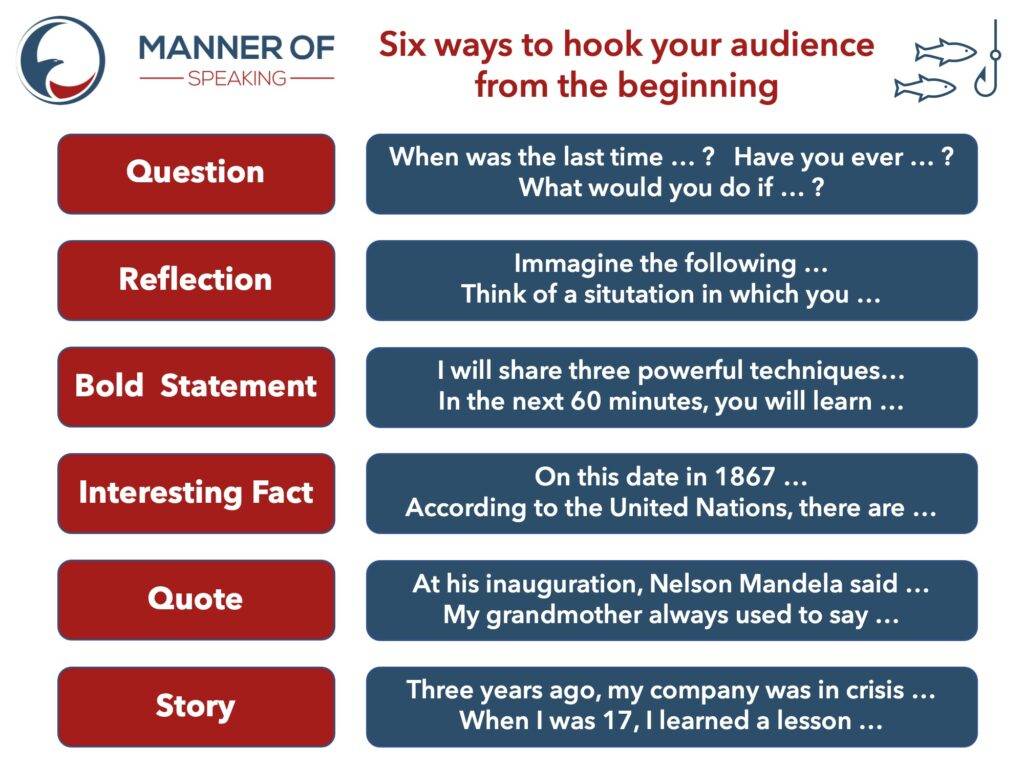
Photo courtesy of Dean Moriarty from Pixabay
Like this article.
Thank you for sharing this brief reminder of simple, effective ways to begin a presentation.
Thank you for the comment, Eric. Yes, there are many simple, effective ways to start one’s talk. It’s too bad that more people don’t use them.
Leave a Reply Cancel reply
Your email address will not be published. Required fields are marked *
Save my name, email, and website in this browser for the next time I comment.
Please enter an answer in digits: 3 × five =
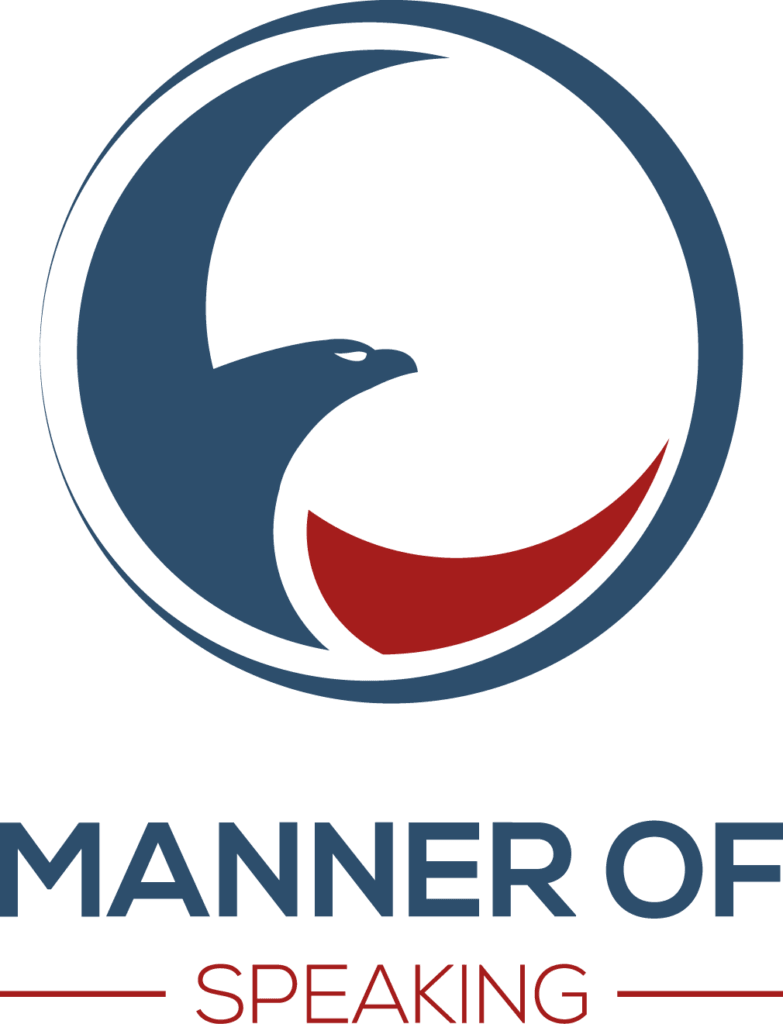
Testimonials

John delivered a keynote address about the importance of public speaking to 80 senior members of Gore’s Medical Device Europe team at an important sales event. He was informative, engaging and inspirational. Everyone was motivated to improve their public speaking skills. Following his keynote, John has led public speaking workshops for Gore in Barcelona and Munich. He is an outstanding speaker who thinks carefully about the needs of his audience well before he steps on stage.
Karsta Goetze
TA Leader, Gore and Associates

I first got in touch with John while preparing to speak at TED Global about my work on ProtonMail. John helped me to sharpen the presentation and get on point faster, making the talk more focused and impactful. My speech was very well received, has since reached almost 1.8 million people and was successful in explaining a complex subject (email encryption) to a general audience.
CEO, Proton Technologies

John gave the opening keynote on the second day of our unit’s recent offsite in Geneva, addressing an audience of 100+ attendees with a wealth of tips and techniques to deliver powerful, memorable presentations. I applied some of these techniques the very next week in an internal presentation, and I’ve been asked to give that presentation again to senior management, which has NEVER happened before. John is one of the greatest speakers I know and I can recommend his services without reservation.
David Lindelöf
Senior Data Scientist, Expedia Group

After a morning of team building activities using improvisation as the conduit, John came on stage to close the staff event which was organised in Chamonix, France. His energy and presence were immediately felt by all the members of staff. The work put into the preparation of his speech was evident and by sharing some his own stories, he was able to conduct a closing inspirational speech which was relevant, powerful and impactful for all at IRU. The whole team left feeling engaged and motivated to tackle the 2019 objectives ahead. Thank you, John.
Umberto de Pretto
Secretary General, World Road Transport Organization

I was expecting a few speaking tips and tricks and a few fun exercises, but you went above and beyond – and sideways. You taught me to stand tall. You taught me to anchor myself. You taught me to breathe. You taught me to open up. You taught me to look people in the eye. You taught me to tell the truth. You taught me to walk a mile in someone else’s shoes. I got more than I bargained for in the best possible way.
Thuy Khoc-Bilon
World Cancer Day Campaign Manager, Union for International Cancer Control

John gave a brilliant presentation on public speaking during the UN EMERGE programme in Geneva (a two days workshop on leadership development for a group of female staff members working in the UN organizations in Geneva). His talk was inspirational and practical, thanks to the many techniques and tips he shared with the audience. His teaching can dramatically change our public speaking performance and enable us as presenters to have a real and powerful impact. Thank you, John, for your great contribution!
HR Specialist, World Health Organization
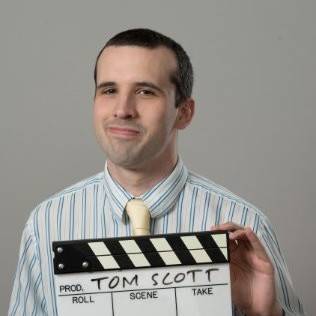
John is a genuine communication innovator. His seminars on gamification of public speaking learning and his interactive Rhetoric game at our conference set the tone for change and improvement in our organisation. The quality of his input, the impact he made with his audience and his effortlessly engaging style made it easy to get on board with his core messages and won over some delegates who were extremely skeptical as to the efficacy of games for learning. I simply cannot recommend him highly enough.
Thomas Scott
National Education Director, Association of Speakers Clubs UK

John joined our Global Sales Meeting in Segovia, Spain and we all participated in his "Improv(e) your Work!" session. I say “all” because it really was all interactive, participatory, learning and enjoyable. The session surprised everybody and was a fresh-air activity that brought a lot of self-reflection and insights to improve trust and confidence in each other inside our team. It´s all about communication and a good manner of speaking!"
General Manager Europe, Hayward Industries

Thank you very much for the excellent presentation skills session. The feedback I received was very positive. Everyone enjoyed the good mix of listening to your speech, co-developing a concrete take-away and the personal learning experience. We all feel more devoted to the task ahead, more able to succeed and an elevated team spirit. Delivering this in a short time, both in session and in preparation, is outstanding!
Henning Dehler
CFO European Dairy Supply Chain & Operations, Danone

Thanks to John’s excellent workshop, I have learned many important tips and techniques to become an effective public speaker. John is a fantastic speaker and teacher, with extensive knowledge of the field. His workshop was a great experience and has proven extremely useful for me in my professional and personal life.
Eric Thuillard
Senior Sales Manager, Sunrise Communications

John’s presentation skills training was a terrific investment of my time. I increased my skills in this important area and feel more comfortable when speaking to an audience. John provided the right mix between theory and practice.
Diego Brait
Director of the Jura Region, BKW Energie AG

Be BOLD. Those two words got stuck in my head and in the heads of all those ADP leaders and associates that had the privilege to see John on stage. He was our keynote speaker at our annual convention in Barcelona, and his message still remains! John puts his heart in every word. Few speakers are so credible, humble and yet super strong with large audiences!
Guadalupe Garcia
Senior Director and Talent Partner, ADP International

- PowerSpeaking ® Get an Expert Foundation
- HighTechSpeaking ® Make Technical Data Come Alive
- Speaking Up: Presenting to Decision Makers ® Win Over Senior Executives
- SalesSpeaking ® Make the Sale
- ConferenceSpeaking™ Prepare for a Speaking Event
- Be Clear, Be Confident, Be Courageous Confident Speaking for Women
- Storytelling Course Tell Stories that Captivate
- Facilitation
- Facilitators
- Management & Staff
- Board Members
- Learning Hub
- PowerSpeaking Live!
Presentations
Communication, facilitation, powerspeaking blog: tips and strategies for crafting presentations, hook, line, and sinker: grabbing audience attention with a great opening.
by PowerSpeaking, Inc. Sep 21, 2016 1:40:19 PM
One of the things that can trip up some subject matter experts who are tasked to make a presentation is their opening. Often it is the first 30 seconds to a minute that sets the tone for the remainder of your presentation — grabbing audience attention and holding it.
Your opening, whether it's a single sentence or a few lines, is where a presentation can be made or broken. It's your chance to hook them, tickling their curiosity so that you can slowly reel them in throughout the rest of your presentation. So how do you captivate an audience with your opening? Follow these tips for creating a great opening.

'Open With the Fire'
"When you advertise fire-extinguishers, open with the fire," says advertising executive David Ogilvy. This cuts to the core of a successful opening line and why this first moment is so important. You may have a relatively small window before an audience tunes you out, so be concise. In your opening, don't waste time establishing your credentials or detailing research background — there will be time for that later. Instead, start with something that cannot be ignored, a dramatic hook that gets people thinking, wondering, and stops them in their tracks.
Simplicity, Not Basic
How many presentations have you seen that started with "Today, we will be discussing..." or "I just want to go over...?" These kinds of introductions are very basic, announcing to the audience what they can expect from the following presentation. They are very often quite boring, akin to a summary at the beginning of a thesis statement. But — from a stylistic perspective — what works for an academic journal doesn't usually work when spoken aloud.
Instead of this basic approach, jump-start the presentation with a simple and compelling insight. " The color green is not what it appears to be." What could this possibly mean? Well, if you are a scientist explaining how our brains perceive color, it means that the way one person sees the color green may differ from the way another person sees it. By opening with this line, you can essentially define your thesis statement ( our perception of color is subjective ) without being overly dry, boring, or getting too into the weeds with data.
Although, it is important to note if you are presenting to decision makers, we teach in our Speaking Up course to present your first line as your bottom line. To say exactly why you are there and what you want is appropriate and not basic for this audience. This is a universal principle derived from our extensive executive interviews.
Ask Questions, Foster Engagement
Even better than starting with insight is to begin your presentation with a question — rhetorical or otherwise. Taking the example above, instead of saying " The color green is not what it appears to be, " try framing it as " Do you know what green really is? "
This begins your presentation with an automatic level of audience engagement: By posing them a direct question (one you can answer in good time), your audience begins thinking about the words you are saying and questioning their own assumptions. You aren't telling them something, you're making them think. This can have a powerful effect, preparing an audience to fully receive and consider what you are about to say.
Give It Personality
Subject matter expert presentations often end up heavy on data, light on personality. Even if you are presenting to a room full of your peers, you'll have an easier time grabbing their attention with a touch of humor or by starting with a personal anecdote than leading with research. The goal is to connect these insights to something personal to your audience by using your personality; your audience can see themselves in you.
Be Evocative - But Leave Them Wanting More
In her 2012 TED Talk, video game designer Jane McGonigal started with this dramatic line : "You will live 7.5 minutes longer than you would have otherwise, just because you watched this talk."
This is the definition of an evocative opening, the kind that makes people sit up straighter in their chairs and lean towards you. She has effectively made her talk a literal matter of life and death, ensuring that her audience stays glued to her every word — her words, after all, could ensure a longer life. Crucially, she stops just short of telling the audience why it will give you a longer life because she doesn't need to . The audience is already in rapt attention, meaning she can take her time and eventually double back to explain her opening.
Having a great opening can make or break your presentation. Once you hook your audience, you will have the time and trust to build your case. Start strong and engagement will follow!

Related Blog Posts: Eliminating, Uh, Filler Words from Your Presentations , Here's To Your Successful Toasts , Hook 'Em in With Impactful Openings
Join Us in Conversation . . .
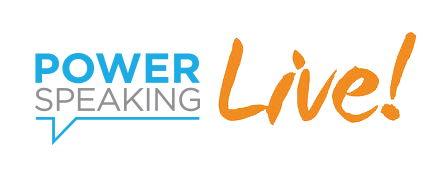
Master the Art of Q&A
Thursday, may 23, 2024, 9-10:00 a.m. pt/12-1:00 p.m. et/5-6:00 p.m. bst.

Sharon Black
President of strategic accounts, robert half.

Master Facilitator and Coach, PowerSpeaking, Inc.
.png)
Communications Manager, Concussion Legacy Foundation

Payal Gandhi Hoon

Karen McDonagh Reynolds
Transformation director & board member, london market joint ventures, powerspeaking, inc..
Topics: techniques for public speaking , tips for public speaking , tips for improving public speaking , great openings , grabbing audience attention , Public Speaking
Don’t Miss Out on Insights!
Subscribe to PowerSpeaking Insights to get our blog, best-practice tips, special offers, and more sent directly to your inbox.

Subscribe to PowerSpeaking Insights
.png?width=270&height=360&name=PS%20Live%20Blog%20Sidebar%20CTA%20(2).png)
Recent Posts
Popular posts.

Address: 1233 Harrison Avenue Redwood City, CA 94062
Fax: 650-631-8660-->
SUBSCRIBE TO POWERSPEAKING INSIGHTS
Get our blog, best-practice tips, special offers, and more sent directly to your inbox.
Copyright 2024 © PowerSpeaking, Inc. All rights reserved.
- Privacy Policy
- Cookie Policy
- My Account My Account
- Cards Cards
- Banking Banking
- Travel Travel
- Rewards & Benefits Rewards & Benefits
- Business Business

Curated For You
Related content, 12 ways to hook an audience in 30 seconds.

Published: October 26, 2021
Updated: October 26, 2021
Do you want to grab your audience's attention from the first sentence? Here's a compilation of great ideas with examples and tips on how to write a good hook.
"When you advertise fire-extinguishers, open with the fire," says advertising executive David Ogilvy . You have only 30 seconds in a TV commercial to grab viewers' attention. The same applies to a presentation. Knowing how to hook your audience in the first 30 seconds of your talk is crucial. This is the time your listeners form an impression of you and of what's to follow. The success of your talk depends upon grabbing your listeners’ attention and keeping them engaged.
What is a speech hook and how does it work?
A hook is a presentation-opening tactic that immediately captures your audience’s imagination. As the word implies, it’s like a worm on a fishing hook that attracts a fish. A hook instantly engages your audience so that they want to listen to what you have to say.
Your hook must come at the start of your talk. First impressions count. Like a fine thoroughbred, you need to start strong out of the gate. Instead, many presenters are more like old, tired workhorses—they start weak by wasting those first precious seconds with platitudes and pleasantries. Brain research shows that we don't pay attention to boring things. Surprise your listeners with some creative speech attention grabbers.
How do you make a good hook?
Coming up with hook ideas is not difficult if you follow some basic guidelines on how to make a good hook.
A good hook is brief, catchy, well-rehearsed and pertinent to your topic. In brainstorming examples of hooks, avoid the dry and conventional.
For example, let's say you are delivering a presentation on investments. Instead of an obvious and trite question such as "How many of you would be unhappy to hear that your house is worth less than you paid for it?" consider using a catchy or thought-provoking question such as "How many of you thought that your home would be your safest investment?"
12 Killer Hooks to Grab Your Audience's Attention
If you're stuck for ideas on how to start with a hook, check out these 12 examples of hooks that will help you grab your audience's attention—and keep it.
1. Use a contrarian approach.
One of the best attention grabber examples is to make a statement of a universally accepted concept, then go against conventional wisdom by contradicting the statement. For example, a market trader starts by contradicting the commonly held advice of buying low and selling high. He says: "It's wrong. Why? Because buying low typically entails a stock that's going in the opposite direction—down—from the most desired direction—up." This tactic is a provocative attention grabber for speeches and it can help engage the audience right away.
2. Ask a series of rhetorical questions.
One of the most common hook ideas is to start with a rhetorical question. Better still, start with a series of rhetorical questions. An excellent example of this tactic is Simon Sinek's TED presentation on how great leaders can inspire action. He begins with: "How do you explain when things don't go as we assumed? Or better, how do you explain when others are able to achieve things that seem to defy all of the assumptions? For example, why is Apple so innovative? . . . Why is it that they seem to have something different? Why is it that Martin Luther King led the civil rights movement?" A series of rhetorical questions stimulate the audience's mind as they ponder the answers.
3. Deliver a compelling sound bite.
Top hook ideas include using a catchy phrase or sound bite that perks up the audience. To create your sound bite, consider your message and package it in a brief and compelling statement. Then explain how it fits into your overall topic or message.
Take inspiration from speakers such as innovation expert Jeremy Gutsche who once used this sound bite in a keynote: "Culture eats strategy for breakfast. This is a sign that is on Ford's strategy War Room. And the lesson from it is not how good your PowerPoint slide deck is; what it really boils down to at the end of the day is how ready and willing your organization is to embrace change, try new things and focus on when you find an opportunity."
4. Make a startling assertion.
When you're stumped for ideas on how to make a hook, use a surprising or amazing fact. That's an easy and sure-fire way to gain people's attention. Take the time to research startling statistics that illustrate the seriousness of what you're going to talk about. For example, a presentation about conservancy can start with: "Every second, a slice of rainforest the size of a football field is mowed down. That's over 31 million football fields of rainforest each year."
5. Provide a reference to a historical event.
Good attention getters for speeches include mentioning a historical event. There are times when the day you present may have some significance in history that can be tied to the subject of your presentation as an opening gambit. You can quickly look up what happened on any day in Today In Sport or a more general site such as This Day In History . You never know what pertinence the day might have that will add some pizzazz to your presentation. It's worth a look.

6. Use the word imagine.
Another effective attention grabber for speeches is the word “imagine.” It invites the audience to create a mental image of something. Ever since John Lennon's famous song, it has become a powerful word with emotional appeal. A good example is Jane Chen's TED talk . She speaks about a low-cost incubator that can save many lives in underdeveloped countries. Chen opens by saying: “Please close your eyes and open your hands. Now imagine what you could place in your hands, an apple, maybe your wallet. Now open your eyes. What about a life?” She displays a slide with Anne Geddes' image of a tiny baby held in an adult's hands as she says this. Combining a hook with a visual is one of the most engaging speech attention grabbers.
There is power in asking the audience to conjure up their imagination, to play along. You can easily adapt this tactic to any topic where you want the audience to imagine a positive outcome or a vision of a better tomorrow. You can also use this opening gambit to ask the audience to imagine being in someone else's shoes.
7. Add a little show business.
If you’re looking for ideas on how to make a hook that's entertaining, consider the world of movies. Movies occupy a central place in most people's lives and a well-placed, pertinent movie quote at the start of a presentation can perk up your audience. Perhaps you have your own inspirational quote from a favorite film. You can also find some classics here: The Best Business Wisdom Hidden In Classic Movie Quotes .
8. Arouse curiosity.
Powerful attention grabbers spark people's curiosity. To do this, you can start with a statement designed to arouse interest and make the audience look up and listen to you attentively. Bestselling author Dan Pink does this masterfully in one of his talks. He says: "I need to make a confession, at the outset. A little over 20 years ago, I did something that I regret. Something that I am not particularly proud of, something that in many ways I wished no one would ever know, but that here I feel kind of obliged to reveal. In the late 1980s, in a moment of youthful indiscretion, I went to law school." The hook here leads to some self-deprecating humor, which makes it even more effective.
9. Use quotations differently.
Often-used hook ideas involve the use of quotes. While many speakers start with an apt quotation, you can differentiate by stating the quote and adding a twist. For example, "We've all heard that a journey of a thousand miles starts with a single step. But we need to remember that a journey to nowhere also starts with a single step." You can also use a quotation from your own life. For example, in a presentation on price versus quality, I have often used a quote from my grandfather, who used to say: "I am not rich enough to buy cheap."
There are numerous sources for quotations, such as The Library of Congress , but you might also consider The Yale Book of Quotations , which brings together over 13,000 quotes. You can also find such resources in app form, including Famous Quotes and Brilliant Quotes .
10. Quote a foreign proverb.
A novel attention grabber for speeches is quoting a proverb from a culture your audience might not be familiar with. There is a wealth of fresh material to be culled from around the world. Chances are your listeners have never heard them, so they have novelty appeal. Here are some examples: "Our last garment is made without pockets" (Italy); "You'll never plow a field by turning it over in your mind" (Ireland); "The nail that sticks up will be hammered down" (Japan), and "Paper can't wrap up a fire" (China). Whatever phrase you select, take the time to read and understand any important context around it, so as to make sure it's appropriate for your talk.
11. Take them through a "what if" scenario.
A compelling way to start your presentation is with a "what if" scenario. For example, asking "What if you were debt-free?" at the start of a money management presentation might grab your listeners' attention as it asks them to look forward to a positive future and it can intensify their desire for your product or service. Exploring hook ideas that use a "what if" scenario may be fruitful as the "what if" concept is easily adaptable to almost any presentation.
12. Tell them a story.
The most engaging and widespread examples of hooks, without a doubt, are stories. Nothing will compel listeners to lean in more than a well-told story. Science tells us that our brains are hardwired for storytelling. But the story needs to be brief, with just the right amount of detail to bring it to life. It must be authentic and have a "message," or lesson, to support your viewpoint. Above all, it must be kind.
A version of this article was originally published on April 11, 2013.
Photo: Getty Images
Trending Content
12 Pretty Good Hooks for Your Next Presentation
“the next three minutes will determine whether you succeed or fail on your next presentation.”.
Every presentation has three main parts – the beginning, the middle, and the end. And among these, the beginning is easily the most important.
You have about 30 seconds to get the audience interested in what you have to say. If that doesn’t happen, anything else you do afterwards will soon be forgotten.
To do that it helps to have a “hook” to grab their attention. Here are 12 tried and true ways to hook your audience and get your presentation off on the right foot.
Why You Need to be Captain Hook
At the beginning of every presentation, there are two main things going on.
- You are trying to introduce your topic and convince people why they need to hear it.
- Your audience is trying to decide whether this will be worth their time.
A good hook is one that quickly gets everyone oriented and engaged, introduces your topic, and makes them willing to listen to more of what you have to say.
A good hook orients, engages, and makes the audience interested in hearing more. Click To Tweet
There are lots of effective ways to do this. The main thing is to do something interesting.
Trying to hook an audience? The main thing is: Be Interesting! Click To Tweet
It’s hard to think of a quicker way to shut down the audience than to begin by mumbling,
“Hello, my name is Bob Smith, and for the next 45 minutes I’m going to be talking about the importance of socks.”
I don’t know why Bob’s talking about socks, and I don’t know why I should listen. I’m already lacing up my track shoes and getting ready to sprint for the door.
So if it falls to you to give the next presentation on the importance of socks (or any other topic), here are 12 ways you can use to engage the audience from the very beginning. I’ll continue with the sock example to help out poor Bob.
Note: If you would like a one-page condensed version of these 12 hooks, plus presentation tips to help them work for you, hit this button:
12 Pretty Good Hooks About Socks
1. Make an Outrageous or Provocative Claim . It’s the same way I started this post. Hopefully it caught your attention and made you want to read more. The same goes for presentations. Be bold, original, challenge common beliefs, then back up your claim.
“Socks are more important than food.” That’s what a man named Kiwi said recently. Kiwi was a homeless man living on the streets of Toronto, Canada. He said that he knew of many pantries and shelters where he could get food, but there was no way he could walk the streets of his city without socks. Socks meant everything to this man and many like him. And if you think about it, socks are very important to all of us…
(Got this quote from The Joy of Sox , a charitable organization that donates socks to the homeless.)
2. Tell a Joke. This is a classic technique that can work well as a way to relax and make the audience receptive. It’s a good idea to try the joke out on some friends first, to make sure they think it’s funny too. Keep it clean, and be ready to move on if you don’t get the laughter you thought you would.
On the first day of summer camp, the director informed all the little campers that he expected them to put on a fresh pair of socks every day. Two weeks later, Johnny failed to appear at the morning flag raising. The director found him still in his cot.
“Why aren’t you lined up with the other boys?” He asked.
“I can’t get my shoes on over fourteen pairs of socks!”
Clearly the boy knew that it was important to have his socks, but didn’t understand why or how the socks were important…
This site at ajokeaday is clean and has a long list of joke categories and a pretty good search function to help you find just the right joke to get started.
3. Tell a Story. Stories remind your audience that you are human, make you relatable, and take down protective barriers people will erect when they think people will be talking at them. Start immediately with the story. You can back up and introduce yourself later.
“ Change your socks ” the instructor ordered. We had just forded a river in the middle of the night and our feet were soaking wet. We were carrying three pairs of socks on this mission. The first was already dirty, and now the second was soaked. But we didn’t want to change our socks. Because in two miles we were supposed to cross another river and we would get wet again. But the instructor didn’t want to hear that. He wanted to make sure we knew he was in charge. Presenting him with the facts only appeared like a challenge to his authority, so he simply said slowly and more deliberately, “ Change. Your. Socks .”
So we changed into our last dry socks by moonlight, he checked every one of us, then we marched on. And we crossed that next river and got wet. Our feet were soaked and sore for the next two days. For a while, it was all I could think about – the foolish order to change our socks. It was the maddest I had ever been. Because when it comes right down to it, the simplest things are the most important in life. The trust of a loved one; food; and dry socks. Most of us take socks for granted…
The best stories are personal ones from your own experience, but you can also find good ones on the internet. This page at businessballs.com indexes their stories by title and topic.
4. Show a Video . Let someone else break the ice for you with a video. It’s an unexpected way to begin, so people will be instantly interested, plus people just like to watch video. Keep it brief and related to the topic in some way. It can be a great way to show the audience what you are talking about, not just trying to describe it. Absolutely double check and rehearse to make sure the video works wherever you will be presenting, and be prepared to react if it fails anyway.
So, who knew you could make a smart phone holder out of an old sock? Well in fact there are lots of good uses for socks, and some actually involve putting your feet into them. Socks are one of the most underrated items of clothing…
5. Ask a Couple Questions. Some people will want to answer, but even if they don’t do it out loud, they will be considering the answer in their minds, so they will be engaged. Asking several questions in a row will stretch the audience’s mind further while also serving as an introduction to your topic. Be sure to pause after each question for best effect.
What do you think is the most important piece of clothing you own? What makes it important? Is it the protection it provides? How often you wear it? The warmth it offers? The way it makes you look? How it makes you feel? For me, there is nothing more important that having on a nice clean pair of dry socks…
6. Show a Picture . This can be a variation of the story method. Share a picture of a person and talk about him, or of a place and why it is important, or of something else related to your subject. People will look at the picture instead of you, so it takes a little pressure off. And the picture itself serves to introduce your topic. Half the job is done before you even open your mouth.
7. Ask a Rhetorical Question . It’s a question that can’t necessarily be answered, but it gets people thinking, and helps you point them in the direction you want to go.
Are socks what truly define us as human beings? Are socks what differentiate us from all the other forms of life on the planet? After all, nobody else on earth is wearing them except us. Can they be that important? These are clearly questions for the ages, and well worth our consideration…
8. Set an Expectation . Not only is it a good idea to let people know what you will be talking about, you will engage their attention much better if you give them something interesting to look forward to.
By the end of this presentation, not only will you know how important socks are in our lives, you will have ten fun facts about socks that you probably didn’t know, and four new sock jokes that you can use to amaze and amuse your friends.
9. Show Them an Object. Bring something with you that you can hold up and talk about. This is a good way to quickly capture the attention of the audience and introduce your topic at the same time.
10. Reference an Historical Event . If the day, week, month, or year is unique in any way that you can relate to your topic, that can be another way to make the topic seem more real or relevant.
Did you know that it was only 135 years ago, on a day very like today, that John Nelson, a Swedish immigrant to the United States, patented the sock-knitting machine? And that one invention was enough to not only change the history of footwear, but lead to the development of a child’s toy as well. Socks have had a huge impact on us…
At this New York Times link , you can see what happened today in history, or pick any other date and see what was going on.
11. Use a Quote . Find a quote from someone recognizable, then think about how you can tie it into your presentation, or turn it on its head.
Over at Brainyquote.com you can find lots to choose from and can even search by topic. Another good source is Wisdomquotes for lots of good quotes by topic or author.
A variation on this idea would be to make the quote your first slide – nothing but the quote in giant words; possibly with a picture of the person who said it.
12. Ask, “What if…?” or “Imagine…” Ask them about something that changes their perspective, like what if you could fly, read minds, be debt-free, go backward or forward in time. You can adapt this to nearly any presentation and it will immediately cause your audience to engage their minds. Ask the question, pause, ask it again for best effect.
Imagine a world without socks. (pause) Imagine… a world without socks. What would it be like? What would change? How would your life be different? (pause) When you think about it, socks are critically important….
These are just 12 possible ways to hook your audience, and there are infinite variations on these ideas. You can even combine them – tell a funny story while showing a picture or turning a quote on its head. The keys are to keep it interesting, original, and fairly brief. Remember, you only have about 30 seconds before they decide whether or not they want to keep listening. Use that time well, and you will be on your way to making a memorable presentation.
If I was able to help Bob get you even the least bit interested in something as mundane as socks, think of what you can do with a far more interesting topic!
With that, since we’re on a sock “thing” today, I’ll leave you with an ode to socks I came across by Chilean poet and diplomat Pablo Neruda . Maybe if I had quoted this to my instructor so long ago, he’d have let me save my last pair of dry socks for after the final river crossing…
Ode to my Socks
Mara Mori brought me a pair of socks which she knitted herself with her sheepherder’s hands, two socks as soft as rabbits. I slipped my feet into them as if they were two cases knitted with threads of twilight and goatskin, Violent socks, my feet were two fish made of wool, two long sharks sea blue, shot through by one golden thread, two immense blackbirds, two cannons, my feet were honored in this way by these heavenly socks. They were so handsome for the first time my feet seemed to me unacceptable like two decrepit firemen, firemen unworthy of that woven fire, of those glowing socks.
Nevertheless, I resisted the sharp temptation to save them somewhere as schoolboys keep fireflies, as learned men collect sacred texts, I resisted the mad impulse to put them in a golden cage and each day give them birdseed and pieces of pink melon. Like explorers in the jungle who hand over the very rare green deer to the spit and eat it with remorse, I stretched out my feet and pulled on the magnificent socks and then my shoes.
The moral of my ode is this: beauty is twice beauty and what is good is doubly good when it is a matter of two socks made of wool in winter.
Wool socks in winter – amen to that!
Egyptian Socks photo; no changes made – https://commons.wikimedia.org/wiki/File:Early_socks.jpg
Sock joke – source: http://www.jokebuddha.com/Socks/recent/4#ixzz3fJpmAwQ7
The Joy of Sox charitable organization donates socks to the homeless http://www.pointsoflight.org/blog/2014/06/04/when-socks-are-more-important-food%E2%80%99
Sock Monkey photo; no changes made – https://www.flickr.com/photos/poplinre/2153204704/ –
Ken served for 26 years in the Infantry, retiring as a Colonel. From leading patrols in the Korean DMZ, to parachuting into the jungles of Panama, to commanding a remote outpost on the Iran-Iraq border, he has learned a lot about leadership, and has a passion for sharing that knowledge with others. Look for his weekly posts, check out his online courses , subscribe below, or simply connect , he loves to talk about this stuff.
GET LEADERSHIP TOOLS
RAPIDSTART LEADERSHIP © 2015-2023 Ι ALL RIGHTS RESERVED
There's a lot here
Would a one-page cheat sheet help, (no strings attached), they are ready to follow..., ...are you ready to lead, subscribe now.
Business growth
Business tips
11 actually great elevator pitch examples and how to make yours

There's a trope in late '90s movies where a motivated, ambitious main character does everything they can to get on the same elevator ride as the CEO of some powerful company.
It usually ends the same way. Our protagonist makes a nervous, fast-paced speech that the CEO ignores while repeatedly pressing the elevator button, and we get a five-second scene with sad music of our main character watching them walk away.
That nervous, fast-paced speech is an elevator pitch example—a bad one, because otherwise, those movies would be nine minutes long and uninspiring. In the real world, an elevator pitch can make a powerful impression and pave the way for business ventures, employment opportunities, and networking. It won't get you a corner office and a fancy title one week into your new job, but it can be an important step in the right direction.
To highlight that difference—and to really dismantle "The Pursuit of Happyness" as a plot—I've put together some elevator pitch examples and a guide on how to write one that actually works.
Table of contents:
Components of an elevator pitch
11 elevator pitch examples
How to write an elevator pitch
What is an elevator pitch.
An elevator pitch is a concise speech in which you introduce yourself and a few key points about what you're pitching, whether it's to acquire investors, promote a product, advertise a business, or even sell yourself as a potential employee. If it takes longer than a minute to get the point across, it's getting too long.
Elevator pitches were originally exclusively spoken—used in business conversations and investor pitches—but have since grown into a written format used for things like websites, social media, video ads, marketing outreach, and media pitches .
You're not trying to convey your entire business strategy or all your selling points. Your goal here is to raise interest, make a connection, and facilitate an opportunity for business in the future.
Let's say you're in the fintech industry and are attending a networking event full of bank representatives and decision-makers. Instead of spending an hour going through your company's history and how it's aiming to be carbon-neutral by 2157, you'd find more success introducing it concisely, pointing out one or two key features and how they could serve your audience's interests.
The pitch begins with a hook to draw your audience in, veers into the value you offer, provides some proof to support your statement, and wraps it all up with a display of what makes you different.
It's relatively easy to incorporate these elements into a short pitch. The difficulty lies in choosing a good hook and phrasing your proposition in a way that appeals to the other side of the conversation.
The hook: This element doesn't need to be fancy or complicated. Make it simple and get straight to the point. For example, if you're pitching a time management tool, your hook can be a personal story like: "When I first started my business, it felt like there was too much to do and not enough time to do it." It can also be a statistic. If you're pitching an online collaboration tool, your hook can be something like: "73% of all teams will have remote workers by 2028."
The value proposition : This is where you provide an overview of the value you're bringing to the table. Discuss what you're pitching and what it does, research your listener's unique needs beforehand, and prepare a compelling argument for how you can meet them.
The evidence: The person you're talking to may be nodding, but that doesn't necessarily mean your point is getting across. Some proof of past success or stats that speak to your success could make that nodding a lot more genuine.
The differentiator: Let them know that you're different—that your product or service isn't just another iteration of what came before. You get brownie points for originality and not quoting any movies.
The call to action: Make sure you're inviting your audience to take action. They have all the details, and they might be interested. It's time to bring it home with a clear call to action . Ask them to connect with you on LinkedIn, invite them for a coffee chat, share contact information, and make sure there's an opportunity to follow up on the conversation.
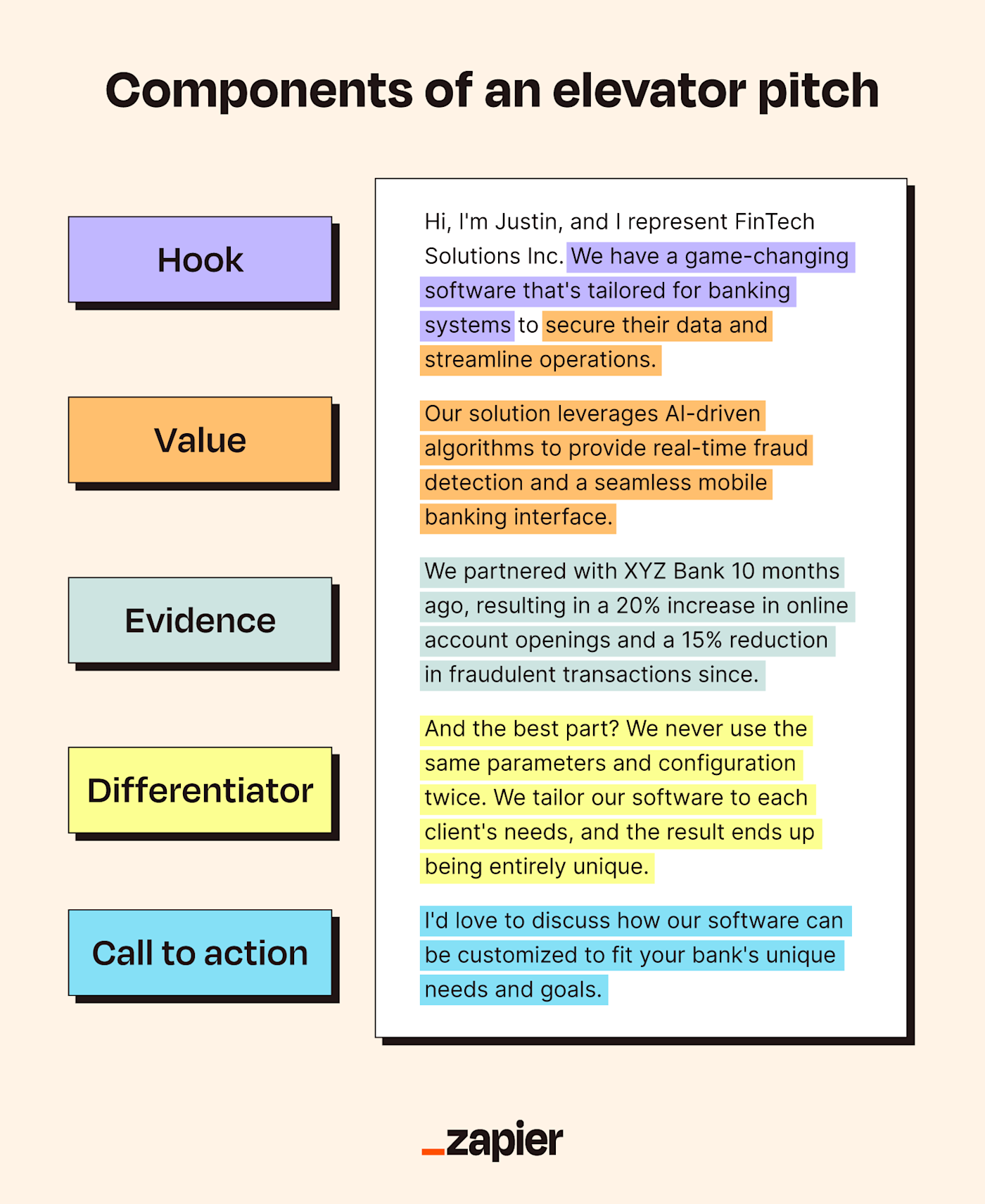
11 elevator pitch examples done right
I rewatched "The Pursuit of Happyness" to see if there was anything I could salvage, but all I walked away with was frustration at the misleading lesson that passion can overcome anything. Passion cannot, in fact, overcome a busy decision-maker who can't wait for you to stop talking.
If you're at all like me, you'll find the following examples a much better use of your time.
1. Startup pitch example
Everyone's got ideas for [shared goal] . But ideas aren't enough.
We took [shared goal] and turned it into a reality.
We developed [solution] at [company name] that's [list of qualities] . We made it possible for [target audience] to [shared goal] .
What sets us apart is our [differentiator, followed by brief overview] .
If you're passionate about [high-level goal] and interested in [benefit of collaborating with you] , let's connect.
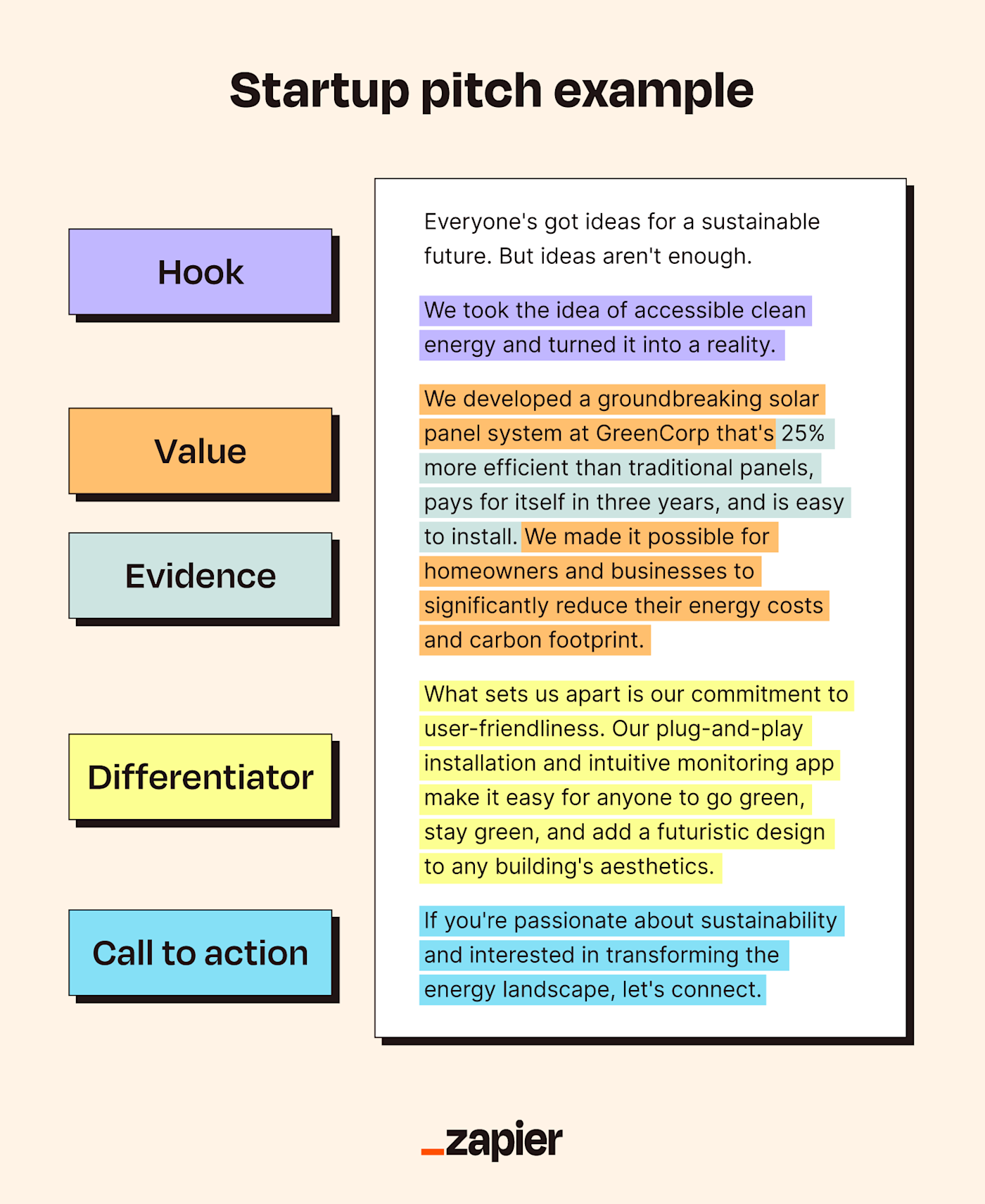
This elevator pitch example demonstrates how to approach potential business partners and investors with a clean energy project. The hook is simple. It leans on the issue and the harsh reality of how little the world does to achieve utopian sustainability. Then it introduces the solution as the company's proactive effort to change the status quo. It pitches efficiency, reduced costs, and access to a larger customer base. Finally, it addresses how ease of use sets the solution apart from the competition and invites further collaboration.
This example is ideal for startups in that it focuses more on the product, what makes it unique, and the features that set it apart, rather than the company's past achievements, success stories, or revenue metrics. It can easily be used to pitch investors and potential clients alike.
You can follow this example by making the problem the centerpiece of the hook. Open with the issue, and position your company's service or product as the solution.
2. Job seeker pitch example
It took me [period of time] to [achieve goal] .
It's always been my priority to deliver [high-level result] , but I want to put my [expertise] to use making [high-level goal/impact] .
At [company name] , I [past experience] that [measureable results] .
I love what I do. But I [differentiator, high-level goal] .
If you're looking for a [position/title] who's [differentiator] , let's chat. I'm eager to explore how I can help your organization achieve its [field] objectives.
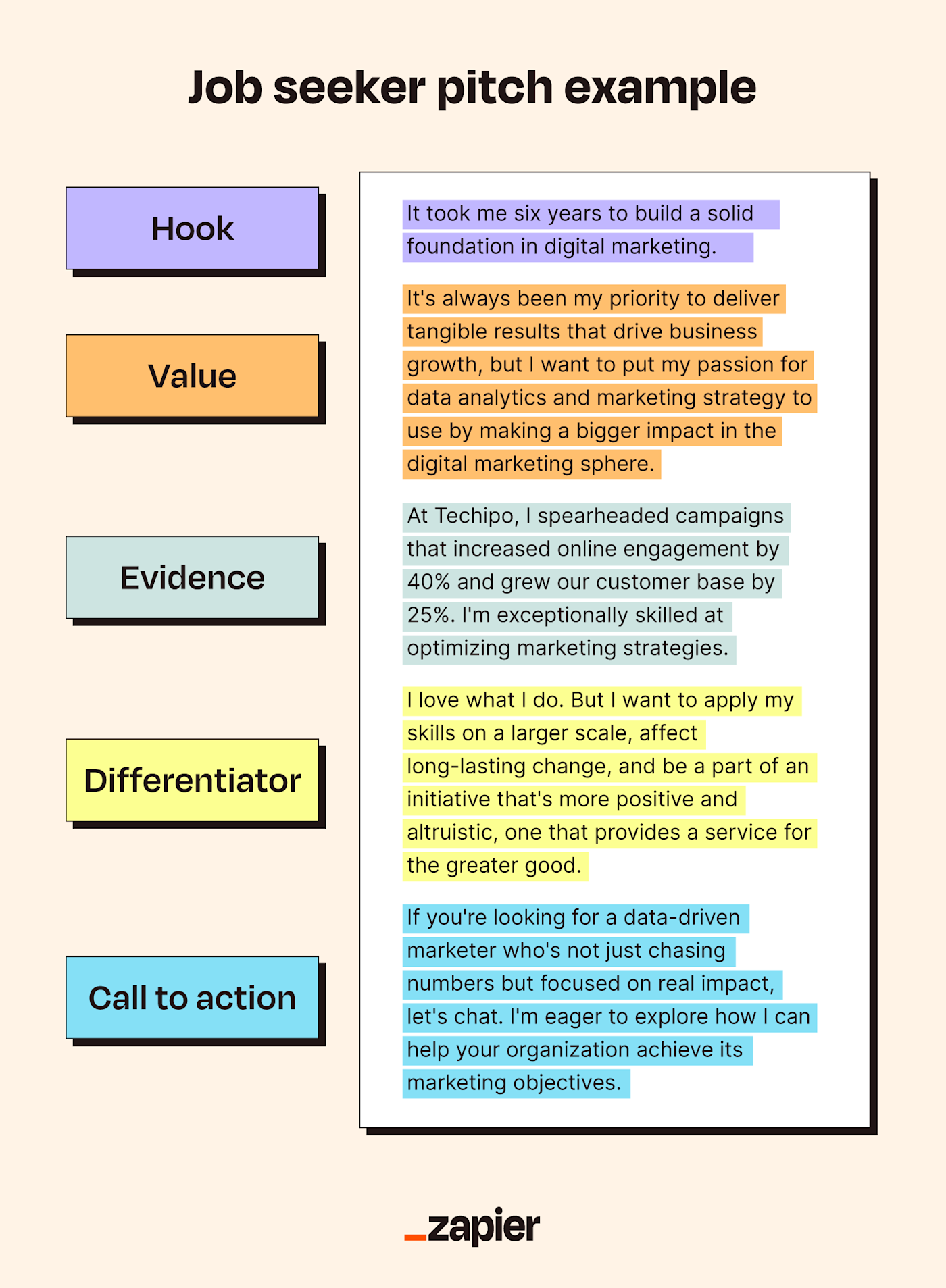
Since tropes are only a good idea when I propose them, I've decided that our job seeker would be making a pitch to GreenCorp, the company from our previous example. Will Smith will not be playing this role.
In this example, the author of the pitch isn't trying to sell a company or a product; they're trying to sell themselves. The hook addresses their background, expertise, and goals. It then veers into past performance results and highlights the key skill set. The uniqueness factor here speaks to GreenCorp's mission, showcasing that the author shares the company's grand goals, empathetic mindset, and desire to help build something positive.
If you're ever job hunting, open your pitch with a concise and direct overview of your background, share your most impressive achievements, and do your research into the company you're pitching.
3. Sales pitch example
Most people [relevant statistic, followed by explanation] .
At [company name] , we've taken the [pain point] out of the equation.
Our [products] are designed for [value proposition] .
They're more than just [product] . They're [differentiator, followed by supporting evidence] .
We're not just salespeople; we're [differentiator] .
So, are you ready to find [product selling point] ? Let's [CTA] .
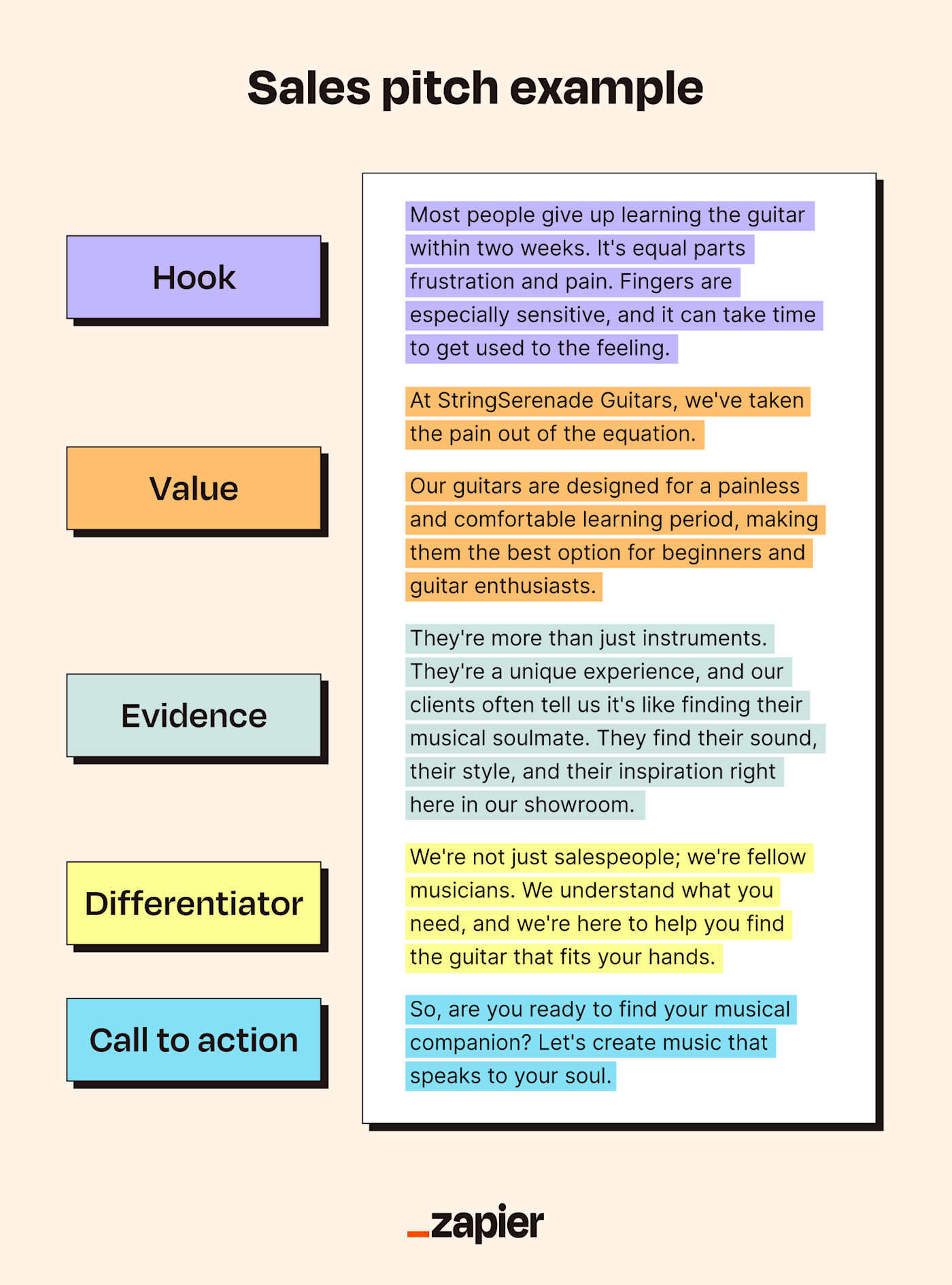
In this example, a guitar shop is pitching its unique guitar design to potential customers. It recognizes a very common problem and ties it to a feeling that most guitar enthusiasts know all too well: giving up too soon. It later positions the author as an expert and fellow musician and utilizes customer reviews as supporting evidence.
A sales pitch will always depend on your industry, product, and customer base. Approach your audience by speaking to their greatest pain points .
4. Networking pitch example
I'm a [position/title] at [company name] , and I've worked on [past experience] .
Over the past [period of time] , I've had the privilege of working with diverse industries, from [industry] to [industry] , and what truly excites me is [shared interest] .
I'm here to connect with other professionals who share my enthusiasm for creative and innovative [field] ideas. I really want to explore new [differentiators and shared interests] .
Let's connect on [communication channel] . I have quite a few compelling [field] resources to share and talk through.
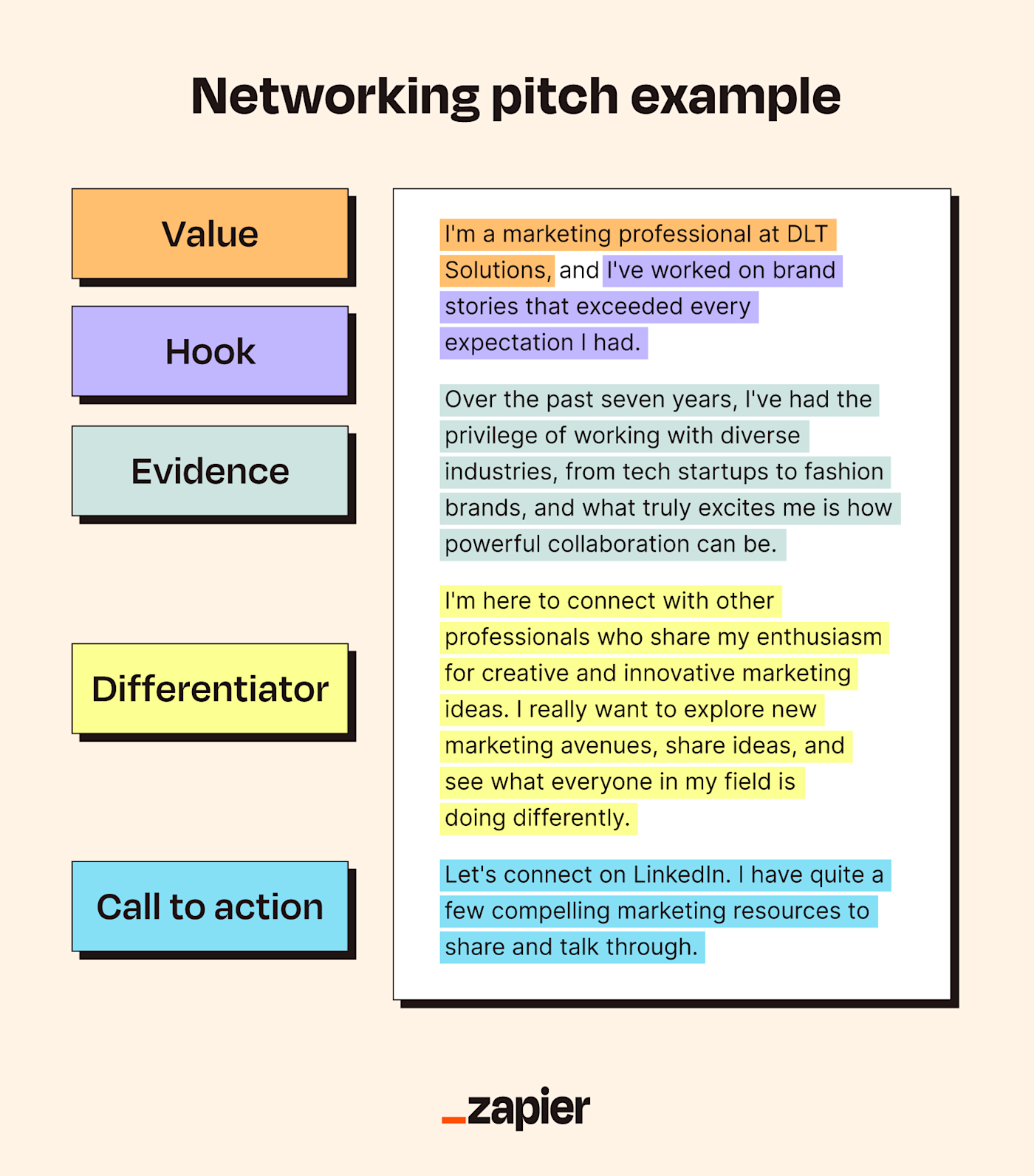
This networking pitch resembles the job seeker pitch with one major difference: the audience shifts from an employer to a colleague. The objective changes, and that affects the entire approach.
In this example, the author isn't trying to convey their efficiency or results in percentages or measurable performance points. They're sharing aspects of their industry that they're passionate about and are interested in discussing. The point here is to make a memorable introduction at a networking event and gather connections .
Ahead of your next networking event, tailor your pitch so that it speaks to your expertise and knowledge without going into too much detail.
5. Investor pitch example
At [company name] , we [business concept offer] , plain and simple.
We [value proposition] .
Our portfolio contains [supporting evidence] .
Why us? Well, we [differentiator] .
We roll up our sleeves and get involved.
We're currently prospecting [target audience] to join us on our journey. If you're ready to be part of the next [field] disruption, let's talk about how [company name] can help.
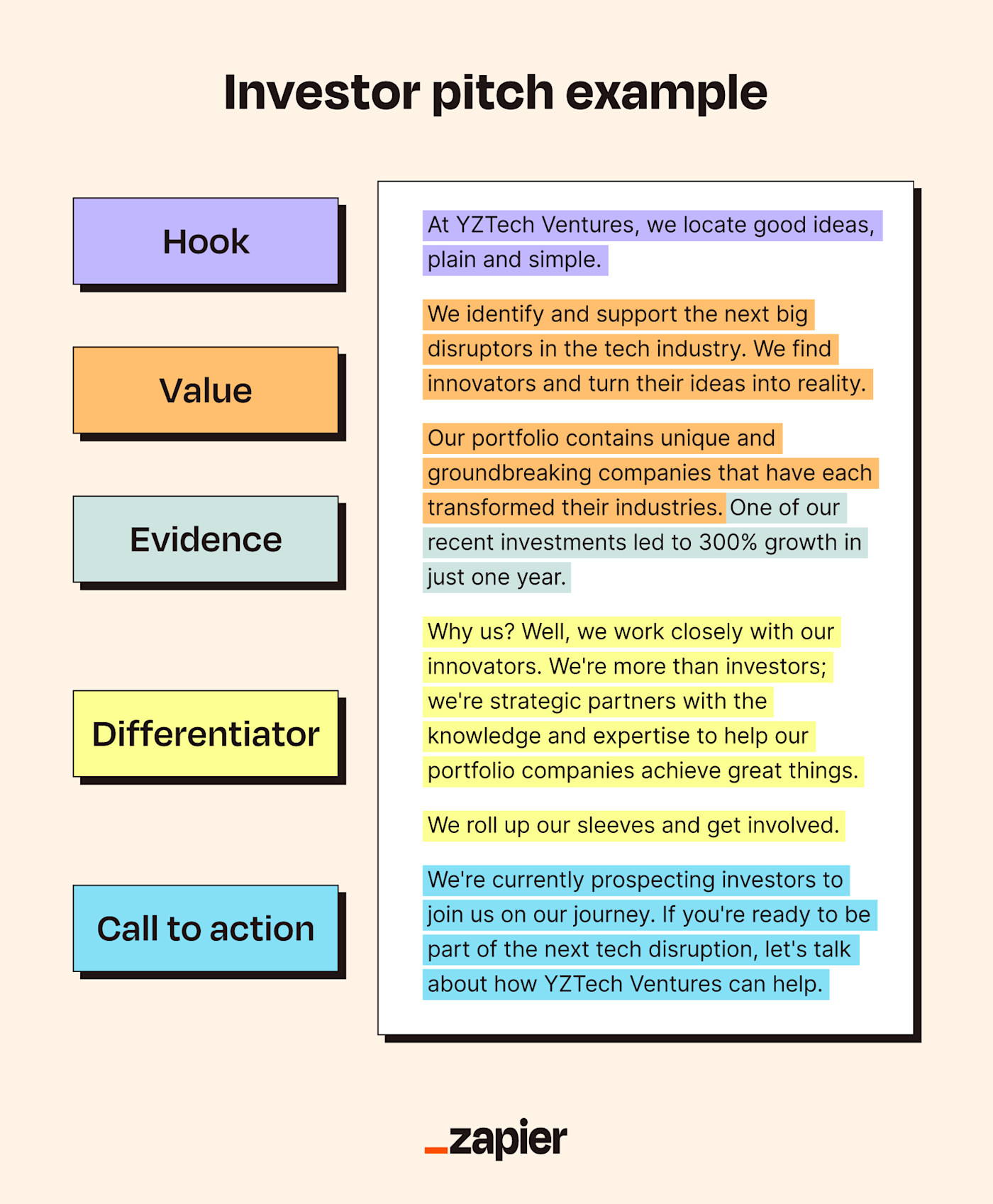
Investors have heard it all a million times over. It's why their faces are so hard to read—set in unimpressed silence. So it's best to make your hook short and to the point. "We do X to achieve Y" can be a breath of fresh air when your job is listening to entrepreneurs pitch their ideas five days a week.
In this example, YZTech Ventures aims to secure investors for promising companies. The hook is straightforward and simple, slowly veering into an overview of the company and why it works.
6. Nonprofit pitch example
Every day, [pain point] .
[Company name] is working to change that.
We're a nonprofit dedicated to [high-level goal] . We've already provided [supporting evidence/achievements] .
We don't want to treat the symptoms; we want to face the root cause of [pain point] . But this will be a losing battle if we're fighting it on our own.
We're always looking for individuals who share our vision and drive to build a better world where [high-level goal] .
If you're ready to make a difference, let's discuss how you can be part of the solution.
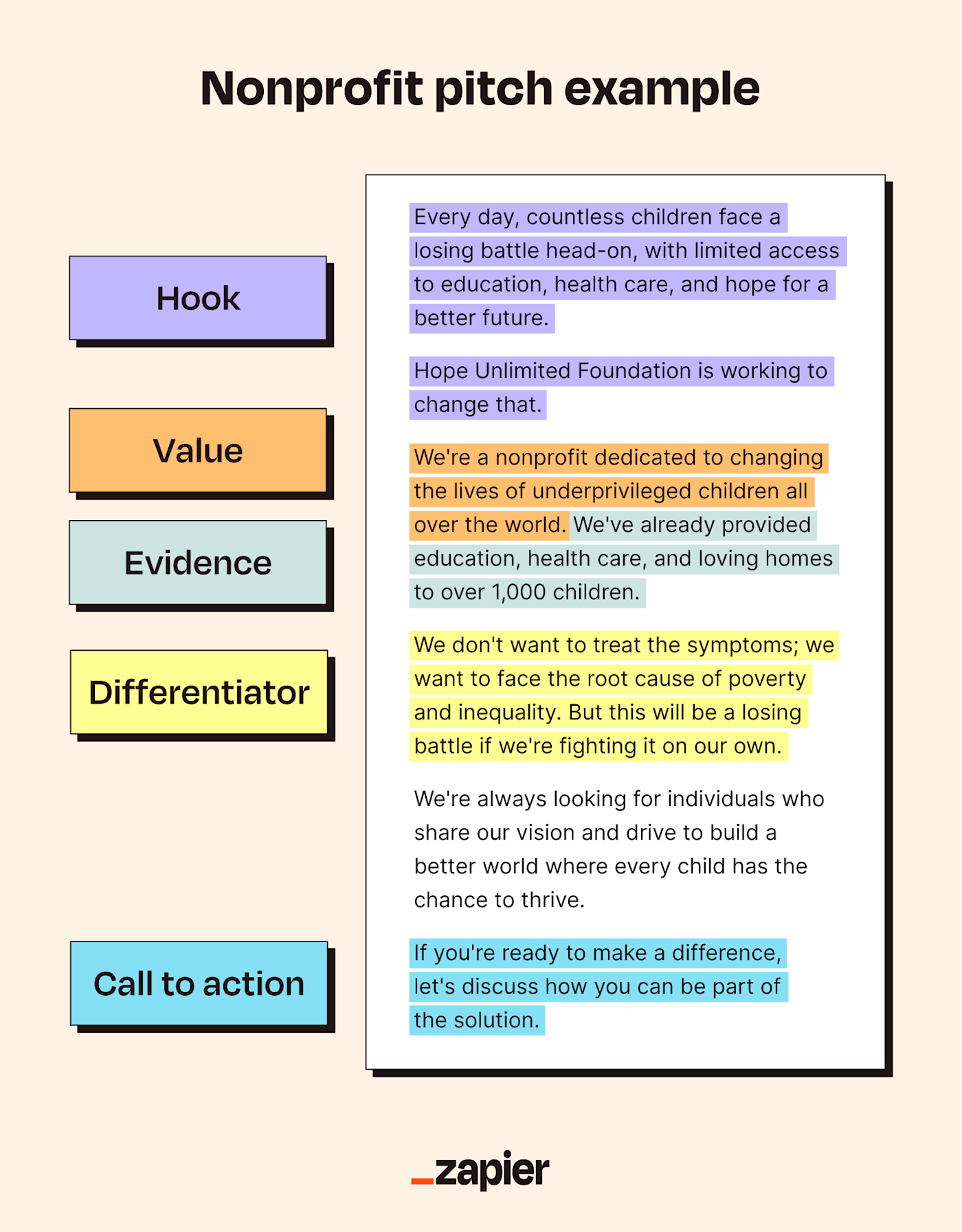
Empathy is the name of the game here, and charities and nonprofits can use it as a unique selling point. The good news is there's very little risk of doing this wrong. The example outlines the cause, its aim, and the efforts being made to find a solution.
If you're pitching a nonprofit or a charity to potential donors, lean heavily on the charity's message and accomplishments.
7. Personal branding pitch example
I'm [name] , and I'm a dedicated [title] . I've helped [past expertise and achievments] .
I do what I do by [value proposition, followed by differentiator] .
I'm here to [offered value] .
There's " [position] " in the title, but I'll be [differentiator] .
Let's schedule a meeting and discuss what you can do.
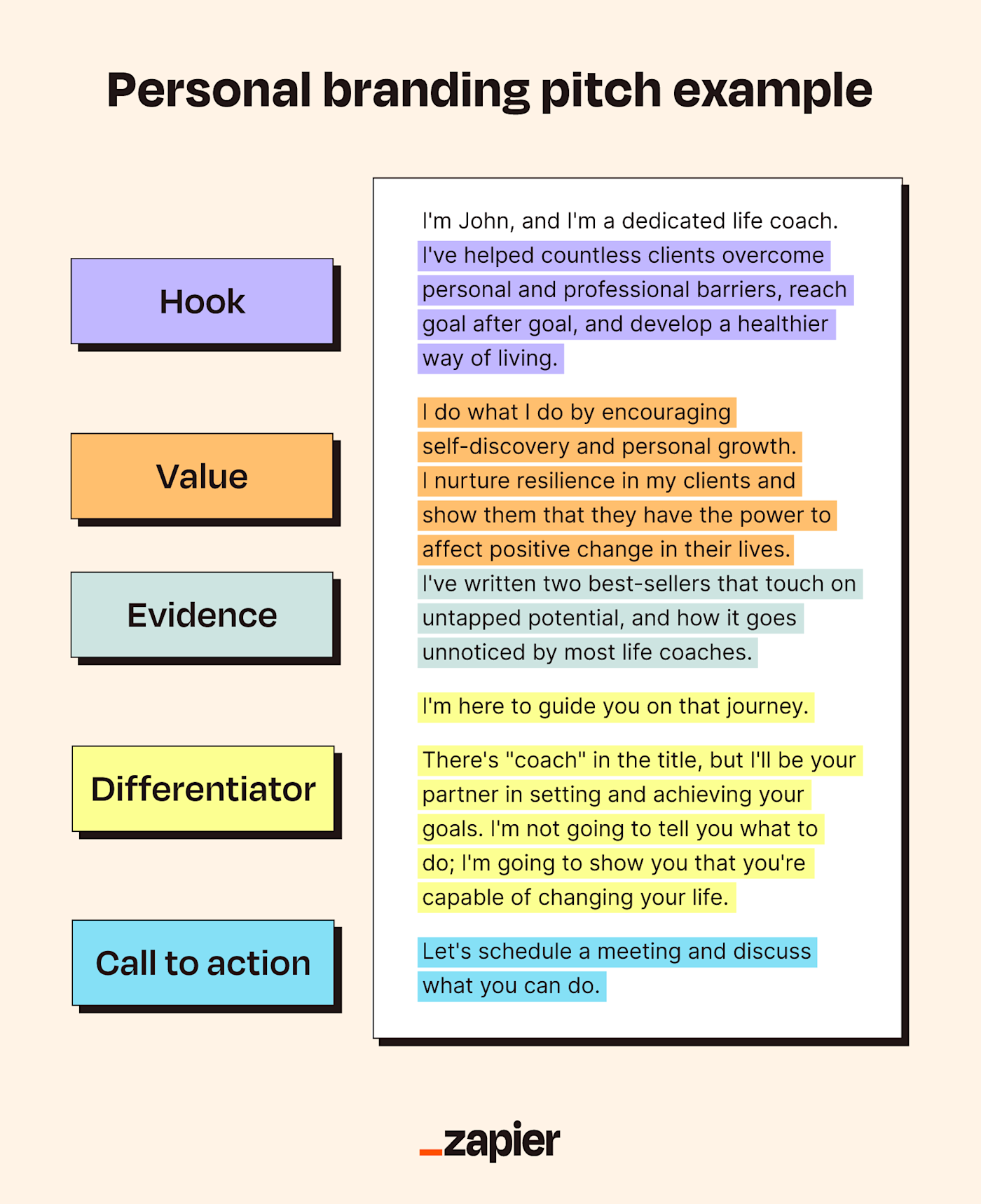
Personal branding comes into play when you're pitching yourself, the individual. Just as companies share their unique idea, proposition, and values, the life coach does the same at a personal level.
If you're ever writing a personal branding pitch, approach it as you would a business. The key difference is to showcase your values and what makes you unique as a person rather than as a corporate entity.
8. Product launch pitch example
I'm very excited to share with you [product selling point] .
At [company name] , [products] aren't just a [basic nature of product] . We see them as a game-changer in [selling point] .
This is why we developed our [product] , a cutting-edge [product overview] .
Imagine all of your [value proposition, followed by key features] .
Our product has already received rave reviews during beta testing, with users reporting [survey results] .
[Product] is now available for preorders! [CTA].
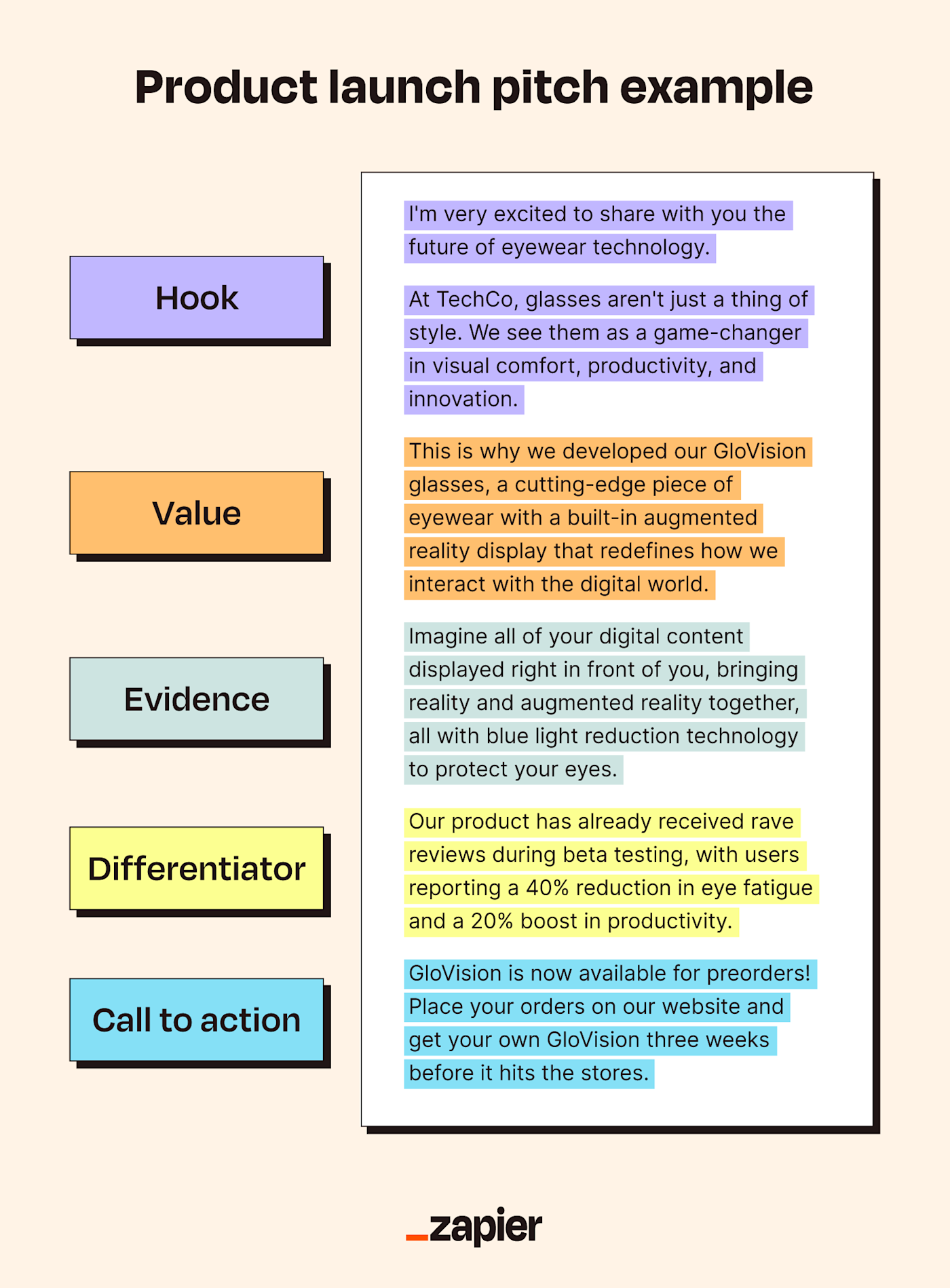
This example focuses less on the company and more on the newly revealed product. The new release speaks for itself and the business at the same time.
The hook immediately positions the product as the future or "the next best thing." The pitch dives into what makes the new product unique, utilizing a hypothetical to paint a picture of what it can achieve.
If you're writing a product launch elevator pitch, focus on the product and let it speak for the company.
9. Rebranding pitch example
We've done great things as [company name] . We've helped businesses [services and past achievements] .
We've since been on a journey of transformation, and it's time for a fresh start.
Our company has grown, adapted, and innovated in response to changing market dynamics. We've [outlined change] . Now, [company name] is about to become [new company name] .
Why the change? We've rebranded to [rebranding reasons] .
With [new company name] , you can expect the same quality, expertise, and dedication you've come to trust. But now, we're adding a fresh perspective and a dynamic spirit to our brand.
We invite you to join us in this exciting phase of our journey. [New company name] is ready to [service/value proposition] .
Let's schedule a meeting and explore how our renewed brand can better serve your evolving needs.
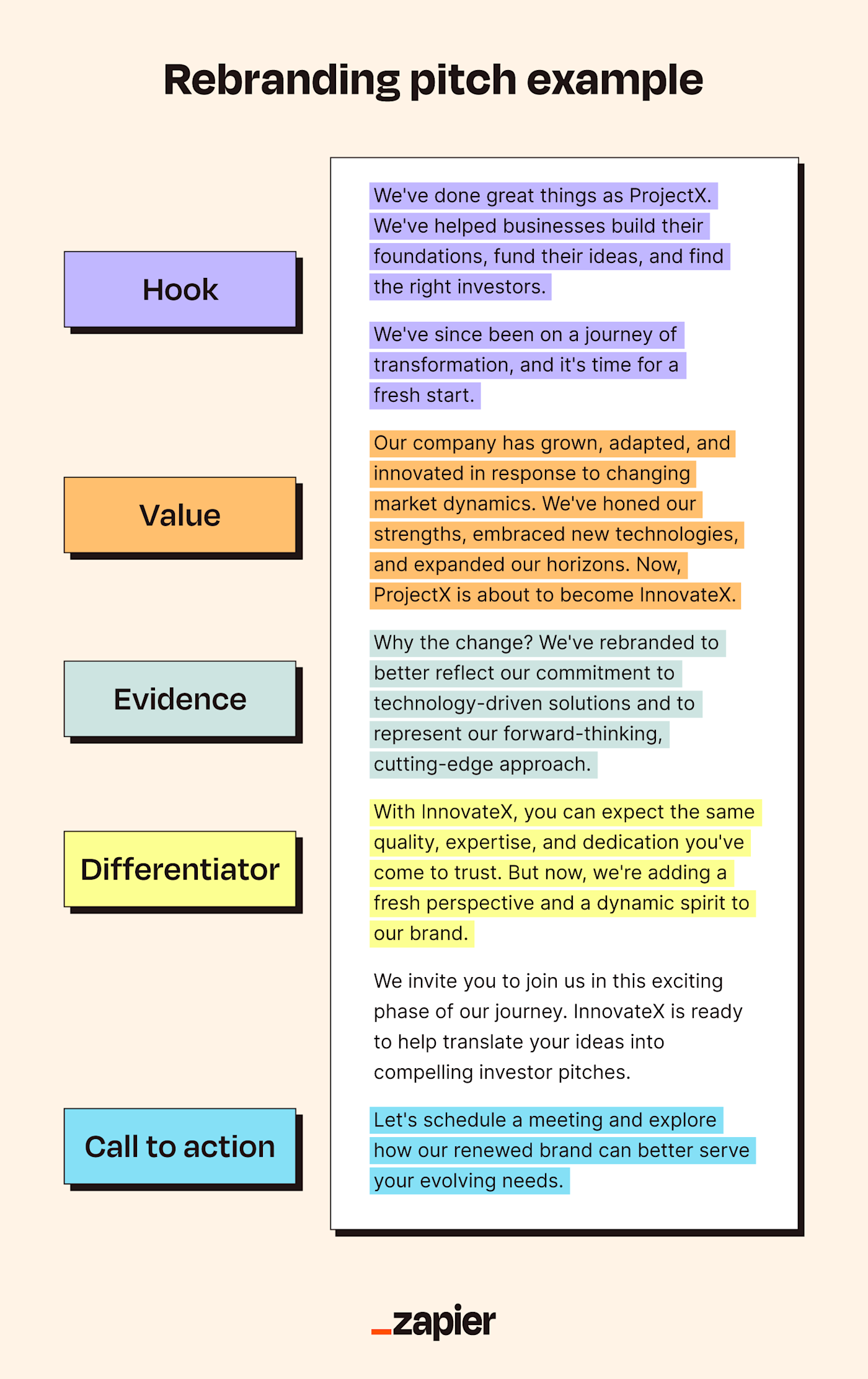
In this example, the hook immediately delivers the reasoning behind the change.
Instead of a value proposition, the pitch offers an assurance that the rebranding won't have detrimental effects. It's designed to address stakeholders and clients as well as provide context.
10. Consulting services pitch example
At [company name] , we specialize in [value proposition] .
With a team of seasoned experts in [field of expertise] , we've successfully guided organizations to [high-level goal] .
Our approach is all about partnership. We take the time to deeply understand your unique market and audience. From there, we [differentiator] .
[Company name] can be the catalyst for your business's transformation. Whether you're looking to [goal] or [goal] , we're here to help.
Let's schedule a virtual meeting to discuss where your company stands and where we can take it.
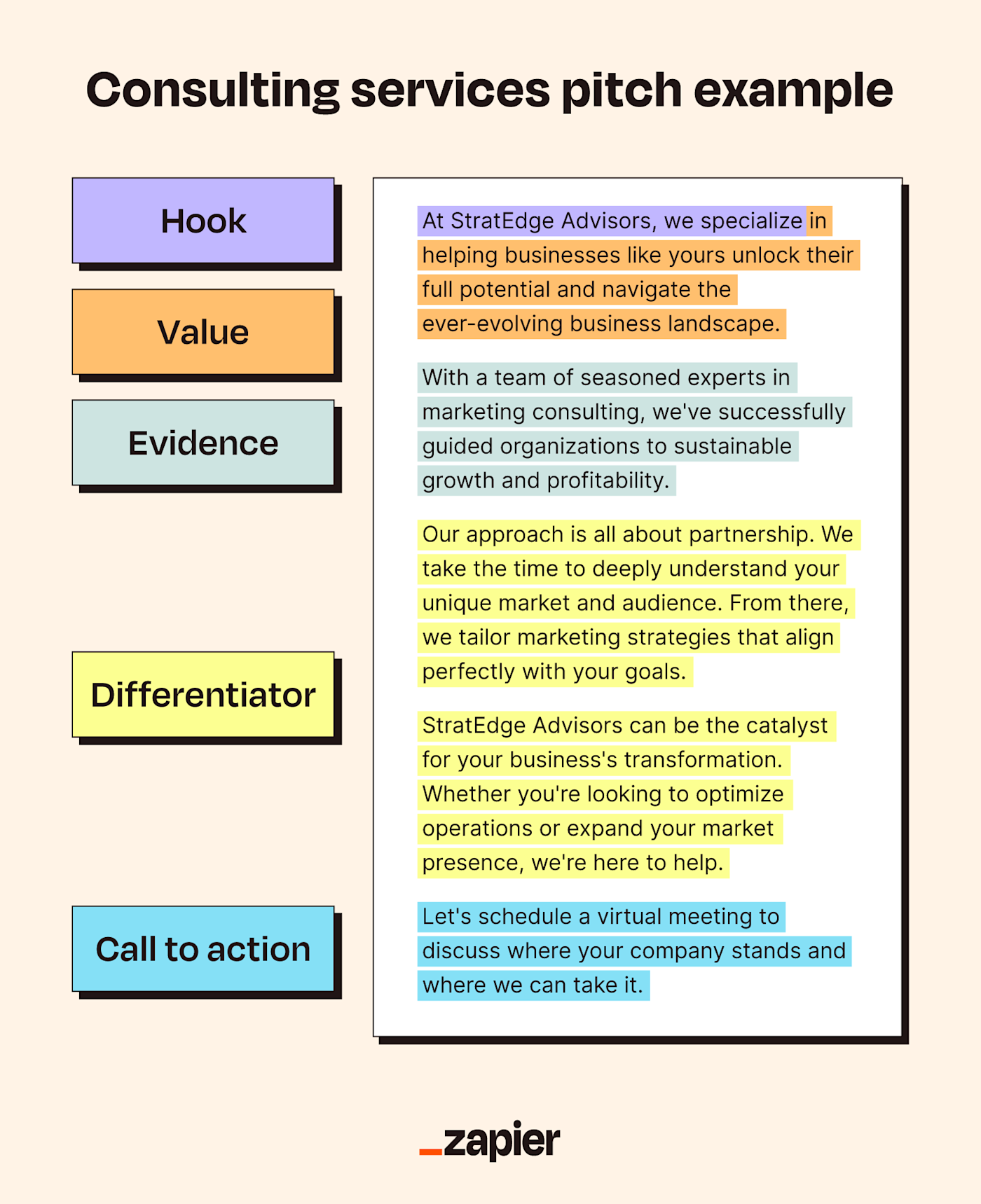
This pitch is designed to attract clients for a consulting service. It takes a collaborative tone in its approach and focuses on areas of growth that pretty much every decision-maker worries about. It makes the solution the centerpiece of its hook instead of the problem, and goes on to briefly outline how the firm's process is structured.
11. Technology solution pitch example
[Relevant statistic].
That's how it goes for your [pain point] .
Imagine you didn't have to worry about [pain point] .
Our [product] is designed to enhance [process] . We help businesses [value proposition] .
One of our recent success stories includes helping a [supporting evidence] .
The thing is, [differentiator] ; we make sure our [product] is specifically customized for your organization's needs.
Are you available to meet next week for a personalized demo?
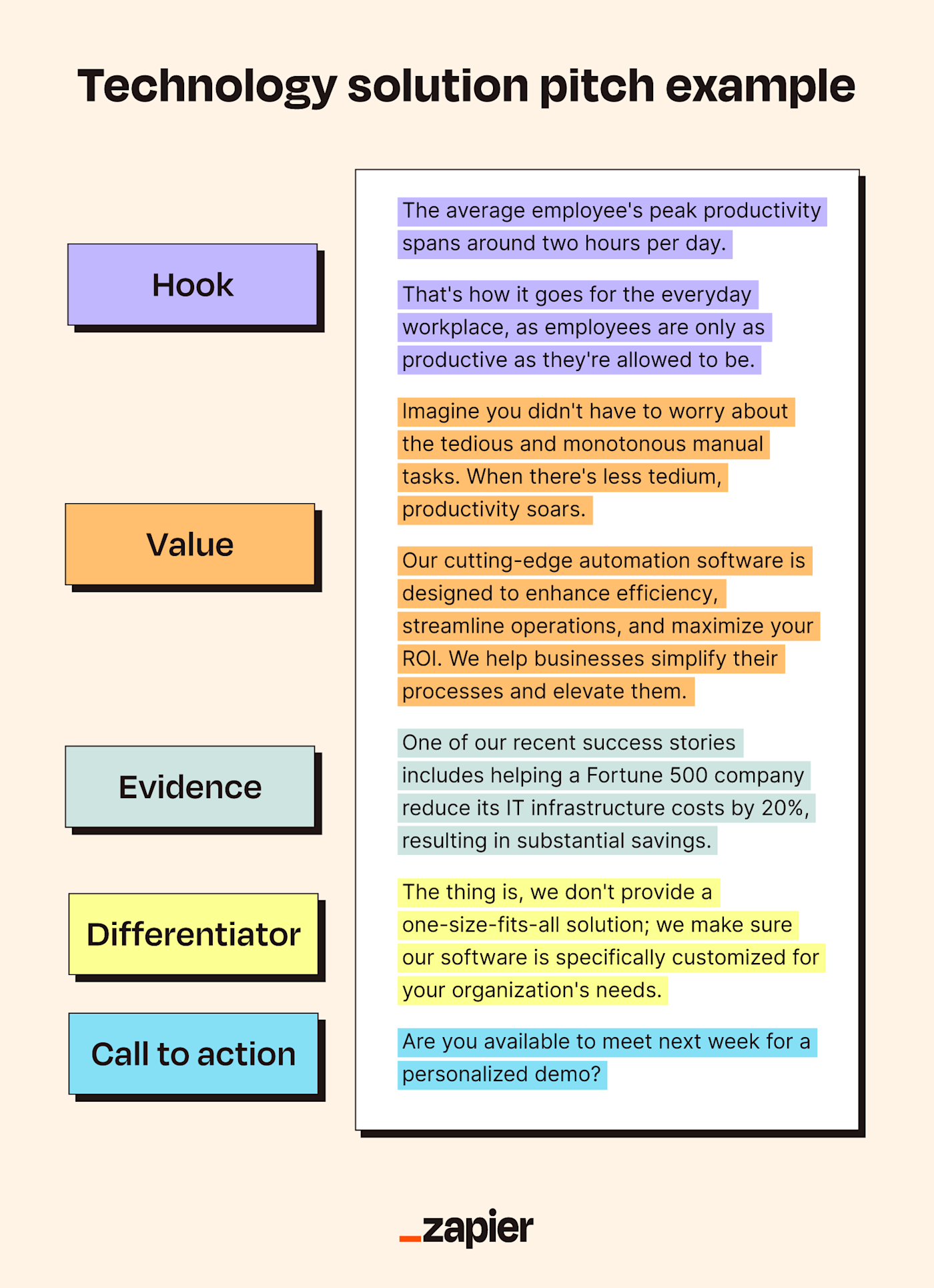
In this example, the hook is a statistic that lays the foundation for the problem and the value proposition. It's a powerful hook that captures the audience's attention and helps you transition into what you really want to say.
You can be an optimist and decide to improvise an elevator pitch. But you'll likely end up taking too many pauses under the guise of sipping your water, and stumbling over your words mid-pitch might waste a precious conversation.
It pays to be prepared, and writing an elevator pitch beforehand can make a big difference.
1. Outline a clear objective
Before you start writing the elevator pitch, focus on your objective . Are you introducing yourself to grow your personal network, pitching a service or product, prospecting investors, or trying to acquire a new client?
Your objective will help you pinpoint the information you want to mention in your pitch.
Tip: Establish success metrics relevant to your objective. Investors will want to know how much revenue your business can generate, while potential clients will want to know the benefits of your product or service. Make sure your success metrics speak to your audience's concerns.
2. Define your audience
One speech won't work across the board. Hollywood says the up-and-coming manager likes to be impressed with a Rubik's cube, while the CEO likes to hear your heartfelt speech about how much this job means to you and how you're expertly overcoming odds.
Both those things are wrong, but the point remains that identifying who your listener is and what matters to them is a nice way to tailor your pitch so that it speaks to their concerns, needs, and bigger pain points. The more you resonate with your audience, the more impactful your pitch will be, and the closer you'll get to a tearful Will Smith movie ending.
Defining your audience goes beyond knowing the name and nature of what might make a potential client.
Tip: Conduct in-depth audience research by diving into your chosen market, competitors, user data, and digital marketing analytics. Then comb through that information to define your audience's pain points and how you're uniquely positioned to address them.
3. Craft a hook
You know what you want to say and why. Now you need an opening statement—a hook that grabs their attention and gets them invested in the rest of your pitch. You want to set the stage for the elements that come next. Make it clear and engaging, but keep it concise. The goal here is to get an attentive listener, not a bored one.
The hook needs to spark the audience's interest. You need to speak their industry's language, show knowledge and expertise, and put your audience research data to good use by pointing out the difficulties and issues they face.
Tip: Use a personal story, a statistic, a fact, or an interesting hypothetical to draw your audience in.
4. Explain your value proposition
Once your audience is paying attention, it's time to dive into the proposition and the value within. What do you and your idea bring to the table? What problems do you solve, and how does that make your listener's life better? How does your solution differ from those they've heard pitched a thousand times before?
Point out the differentiating factors that make you and your business unique, whether it's the groundbreaking tech you've patented or the better pricing options your competitors can't keep up with.
Tip: Write down all the aspects that make your business different, and choose the most compelling ones for the pitch.
5. Support your pitch with evidence
Who doesn't like real-life measurable data? Well, Hollywood doesn't, but that's just because no amount of Hans Zimmer music can make your 325% ROI cinematically engaging. You can be confident that your audience will want to hear success stories that support your proposition.
Have a few successful case studies from former and current clients ready to drive the point home and turn a semi-interested listener into an engaged party.
Tip: Draw on your own expertise, and use performance statistics and relevant metrics from previous projects.
6. Keep it concise
It's called an elevator pitch for a reason. You have under a minute to get your entire pitch across to a busy decision-maker who doesn't have all day. Cut the fluff, and only say what you feel certain will convince your recipient to take your side.
Tip: Practice reading your pitch out loud in the mirror. Use a timer to measure how long it takes to deliver it comfortably.
7. End with a clear call to action
Since the point of an elevator pitch is to generate interest, you'll want to end it with a clear call to action—one that evokes a response and maybe a more in-depth conversation.
If you're pitching a service, you can offer to schedule a meeting to further outline your services and how they can help the listener. If you're pitching a product, you could offer to schedule a demo to prove it can improve their business. Get creative here, and aim to turn that interest into a meeting.
Tip: Lead your audience to connect with you beyond the pitch. Schedule a meeting or a coffee chat, exchange contact information, and make sure there's room for a longer discussion.
8. Prepare to answer questions
You can't just deliver your pitch and then hit the open bar at the networking event. Be ready to answer questions.
Questions at this stage mean your listener is intrigued, curious, and interested. At this point, feel free to provide as much context in your answers as you'd like. The elevator pitch has already ended, and it served its purpose. Go in-depth and provide context.
Tip: Write down a few questions based on your own market research. Ask yourself what your customers, investors, and audience might be curious about. Prepare your answers so you're never surprised.
Make a unique first impression
Elevator pitches exist because humans have shorter attention spans than goldfish, and we really need a leg up on our aquatic competition.
Opportunities are fleeting, especially when businesses are launching every day. In an oversaturated environment, an elevator pitch can help you make an impression that lasts. And who knows, you might just have what it takes to inspire a 50-million dollar movie that Will Smith can "misty-eye" his way through.
Related reading:
How to pitch your small business to the press
How to use personalized sales pitches to convert clients and sell more
ChatGPT prompts that will generate great sales emails
Email etiquette: How to ask people for things and actually get a response
How to create a project plan (with project plan templates)
Get productivity tips delivered straight to your inbox
We’ll email you 1-3 times per week—and never share your information.

Hachem Ramki
Hachem is a writer and digital marketer from Montreal. After graduating with a degree in English, Hachem spent seven years traveling around the world before moving to Canada. When he's not writing, he enjoys Basketball, Dungeons and Dragons, and playing music for friends and family.
- Small business
Related articles

How to write a letter of introduction for your freelance business
How to write a letter of introduction for...

What is prompt engineering?

How to create a sales plan (and 3 templates that do it for you)
How to create a sales plan (and 3 templates...

How to build a B2B prospecting list for cold email campaigns
How to build a B2B prospecting list for cold...
Improve your productivity automatically. Use Zapier to get your apps working together.


15 Killer Hooks to Captivate and Engage Your Audience
Talk with a deliverability expert!
No need to flee, it’s totally free
TABLE OF CONTENTS
Do you want to make sure that your readers are completely hooked on your content and keep coming back for more? Are you looking for new ways to captivate and engage them so they’ll stick around till the very end of your post?
If so, then you need killer hooks – those techniques that grab attention, capture interest and compel readers to take action.
From personal anecdotes and storytelling to humor, surprise elements, questions and promises – this article will provide 15 clever hooks guaranteed to draw in even the most distracted reader.
Read on if you’re ready to start crafting posts that have maximum impact!
What is a hook message to grab the reader's attention?
The hook message in an article or piece of content is the attention-grabbing statement or opening sentence that captures the reader’s interest and encourages them to read further. A compelling and effective hook message not only attracts attention but also keeps the reader engaged and interested in what follows.
According to studies, the average attention span of a person is only 8 seconds, which makes the hook message all the more important. And given the overwhelming amount of content available online, a well-crafted hook can make all the difference between a reader continuing to read or scrolling past.
There are several types of hooks that can be used, such as posing a question, using a startling statistic, or telling a story. However, the most effective hooks are typically those that tap into the reader’s emotions or curiosity.
One example of an emotional hook could be starting an article with a relatable personal story. This immediately sets the tone for the article and creates an emotional connection between the reader and the writer. Another type of hook that is effective is using a surprising or unexpected fact that challenges common assumptions.
Regardless of the type of hook used, the goal remains the same – to captivate the reader’s attention and encourage them to read on. So, whether you’re writing a blog post, article, or marketing copy, taking the time to craft an attention-grabbing hook can make all the difference in capturing your audience’s interest and keeping them engaged.
15 killer hooks to engage your audience
✅ shocking statistics.
Use a statistic that will get your audience thinking and wanting to know more.
✅ Interesting Quotes
Quotes can be powerful intros that give your audience a new perspective on your topic.
✅ Personal Anecdotes
Personal anecdotes are an effective way to humanize your message and connect with your audience.
✅ Surprising Facts
Surprising facts are great hooks that will leave your audience intrigued and wanting to know more.
✅ Contrasting Ideas
Contrasting two different ideas can be an effective way to draw your audience in and spark interest.
✅ Bold Statements
Bold statements can challenge your audience’s thinking and get them engaged in your message.
✅ Humorous Anecdotes
Humor is a great way to break the ice and ease the tension in your presentation.
✅ An Alluring Question
Asking an intriguing question can make your audience curious and keep them engaged.
✅ Powerful Images
Powerful images can captivate your audience and give your message an emotional impact.
✅ Unique Analogies
Analogies can be an excellent way to help your audience better understand complex concepts.
✅ Startling Comparisons
Comparing two different things can be a great way to highlight the importance of your message.
✅ Conspiracy Theories
Conspiracy theories can be a fun way to engage your audience and get them thinking critically.
✅ Controversial Ideas
Controversial ideas can be used to stimulate discussion and engage in healthy debate.
✅ Shocking News Stories
Using shocking news stories can be an effective way to get your audience’s attention and keep them engaged in your message.
✅ Emotional Appeals
Emotional appeals can be used to connect with your audience on a personal level and inspire them to take action.
Most famous hooks in history
“Four score and seven years ago…” – This is the opening line of Abraham Lincoln’s Gettysburg Address, instantly capturing the attention of the audience with its memorable and poetic beginning.
“I have a dream…” – Martin Luther King Jr.’s iconic speech begins with this powerful and aspirational statement, immediately drawing the audience in with its hopeful and inspiring tone.
“In a hole in the ground, there lived a hobbit…” – J.R.R. Tolkien’s novel “The Hobbit” starts with this intriguing line, sparking curiosity and inviting readers into a fantastical world.
“It was the best of times, it was the worst of times…” – Charles Dickens’ “A Tale of Two Cities” begins with this contrasting statement, setting the stage for a story filled with drama and tension.
“Once upon a time…” – This classic opening line is often used in fairy tales and folklore, instantly signaling to the audience that they are about to embark on a magical and enchanting journey.
“It is a truth universally acknowledged, that a single man in possession of a good fortune, must be in want of a wife.” – Jane Austen’s “Pride and Prejudice” starts with this witty and satirical sentence, immediately capturing the attention with its ironic tone and social commentary.
“Call me Ishmael.” – The opening line of Herman Melville’s “Moby-Dick” is simple yet intriguing, drawing the reader into the narrative by introducing a mysterious character.
“It was a bright cold day in April, and the clocks were striking thirteen.” – George Orwell’s “1984” begins with this unsettling and unusual line, immediately creating a sense of intrigue and setting the tone for a dystopian tale.
“In a galaxy far, far away…” – The opening crawl of the “Star Wars” films grabs the audience’s attention by transporting them into a vast and epic science fiction universe.
“To be or not to be…” – Shakespeare’s famous soliloquy from “Hamlet” starts with this existential question, instantly captivating the audience with its introspective and philosophical nature.
Most famous hooks in marketing to engage the audience
“Just do it.” – Nike’s iconic slogan is a short and powerful hook that inspires action and motivation, appealing to the audience’s desire for achievement and self-improvement.
“Think different.” – Apple’s memorable tagline challenges the status quo and appeals to individuals who want to stand out and embrace innovation.
“Got milk?” – This simple yet catchy slogan from the California Milk Processor Board prompts the audience to consider the importance of milk consumption, making it memorable and thought-provoking.
“Finger-lickin’ good.” – KFC’s slogan evokes sensory appeal and mouthwatering sensations, creating a strong connection between the audience and the product.
“Melts in your mouth, not in your hands.” – M&M’s clever tagline emphasizes the product’s quality and convenience, leaving a lasting impression on the audience.
“Because you’re worth it.” – L’Oréal’s slogan speaks to the audience’s desire for self-care and self-worth, positioning their products as a way to indulge and pamper oneself.
“The breakfast of champions.” – Wheaties’ tagline positions their cereal as fuel for success and accomplishment, appealing to athletes and those striving for greatness.
“I’m lovin’ it.” – McDonald’s popular jingle encapsulates the joy and satisfaction associated with their fast-food experience, creating an emotional connection with the audience.
“The happiest place on Earth.” – Disneyland’s slogan taps into the audience’s longing for happiness and magical experiences, creating a desire to visit the theme park.
“Red Bull gives you wings.” – Red Bull’s tagline implies that their energy drink provides an instant boost and a feeling of empowerment, appealing to individuals seeking energy and vitality.
These hooks have become iconic in marketing because they effectively capture the attention and resonate with the desires, emotions, and aspirations of the target audience.
Crafting the perfect hook can elevate your content and create a lasting impression with readers. Many of these hooks allude to a story, so focusing on how the hook will capture the audience’s imagination is key.
If you want to leverage your story-telling skills and captivate your reader from beginning to end, a great hook is essential. With guidance and practice, it can be easy to craft an eye-catching hook for any type of content that you produce.
Remember to focus on who you are writing for and weaving in interesting tidbits along the way. Hooks don’t have to be complex or long; they just need to evoke curiosity so readers continue exploring your content, making it enjoyable and easy to read!
So go ahead — get creative with your 15 killer hooks! Who knows — maybe one will be the spark that captures countless readers’ attention.
- All Insights
- Top-Rated Articles
- How-to Guides
- For Parents
Learn Public Speaking: What Hook is and What are Its Common Types (Part 1)
Hello everyone. I'm, like, really nervous, so please listen to me. OK, um, I spent a long time preparing for this topic and I hope I remember everything but, like, please excuse me if I forget or something, OK? Do you like fishing? Who has ever gone fishing? I have. Today my speech is about fishing. Greetings! Your mission, should you choose to accept it, is this. You need to get the attention of this audience and make them listen to your speech. They're restless and don't have a long attention span. They've heard too many bad speeches already. 20 seconds is all you have. Your weapons are your mind and your voice. We're counting on you, Agent LL. As you might have guessed, this article will focus on hooks – what they are, why they are important, and what different types of hooks you can use to introduce the topic of your speech in an engaging and entertaining way. So then, what is a hook? Are we going fishing? Not exactly. But when you're giving a speech, you do have to “fish” for the attention of your audience. You have to hook them! You have to engage your audience. That means you must give the audience some reason to want to listen to what you're about to say. This might be difficult. Your audience might be tired and restless, or distracted by other thoughts, like, "Hmm, when will we get a break?" or, "What time is lunch?" Just think about how you felt last time you were an audience member, when someone stood up to speak, and within the first few sentences you've already become bored and couldn’t wait until their speech was over. However, really great speakers are able to capture their audience's attention within just a few sentences and keep them engaged for the entire speech. They give a fun, interesting, or shocking hint to the audience about what is to come and make the audience look forward to the rest of their speech. This is the hook. Then, what makes a good hook? The most important thing for a hook is to surprise the audience or make them curious. It doesn't matter how you do that, but if you can surprise them or make them curious with a story, statement, question, statistic, sound, or dance, then you’ll win their attention – at least for a short while. Your hook should relate to your topic. For example, it wouldn't be useful to start with some shocking statistics about air quality when your main topic is about Harry Potter. Yes, it might get their attention, but unless the hook clearly relates to the topic, it would only confuse the audience. For a short speech, your hook should only be two to three sentences long. This is why creating a good hook can be challenging – you have to captivate your audience in a way that relates to your topic, in a short amount of time. Let's take a look at some of the different types of hooks you can use. There are many different possibilities for hooks, so feel free to get creative and wacky! For now, we'll just look at some of the more common types. First, is the personal anecdote. This is a short story about something that you, or someone you know, has experienced. By making it personal, it allows the audience to feel a little bit closer to you as the speaker because you're sharing something about yourself. For example, if you were to give a speech on the topic of video game addiction, you might start off with a hook like this: "The blue flickers lit up the stacks of ramen cups and Coke cans all around me as I stared lifelessly into the rectangular void. My headphones drowned out the calls of my family. I really didn't realize how bad it had become until the nineteenth hour." Short, descriptive, and surprising! The second is the shocking statement. The idea here is to shock or provoke your audience. You never want to offend them or be inappropriate, but if you’re able to challenge their views, then this can be a powerful way of gaining their attention. For example, "I have been going to school for 6 years, and I have yet to learn one thing I consider valuable!" In an audience of fellow students, parents, and teachers, this would certainly grab their attention! While many people would initially disagree, you could then go on to explain your main topic like "Why children need a say in the curriculum," or "A child's perspective on how to improve learning." After learning about the personal anecdote and the shocking statement, you might have already found your favorite hook. Since most speakers usually have one or two “go-to” hooks, in part two of this article, you’ll be introduced to two more cool hooks, so you have more options to choose from. Let’s go!
Learn more about the LL Method to Public Speaking & Debate .

Related Insights
Learn public speaking: what hook is and what are its common types (part 2), preparing for an impromptu speech learn how to hook your audience with relatability, what is public speaking and competitive debate (part iii).

- 5 Prep Tips for BP
- Top Speech Introductions
- Public Speaking and Debate Competitions
- Incorporating Humor
- Logical Fallacies
- How-To: Prepare for Debate Tournaments
- How-To: Judge a Debate
- How-To: Win a BP Debate
- How-To: Win An Argument
- How-To: Improve at Home
- Team China Wins World Championship
- Ariel Wins Tournament
- Jaxon Speaks Up
- Tina Improves

More Good Stuff:
How hiring a professional can improve your commercial real estate powerpoint presentation.
Ready to transform your commercial real estate PowerPoint presentations into impactful visual narratives that drive results? Partner with KOAD.
5 Tips for Improving Your Upcoming Healthcare PowerPoint Presentation
Creating an engaging healthcare PowerPoint presentation can feel like a daunting task, especially when you're already juggling numerous day-to-day responsibilities.
7 Ways to Make Your Financial Presentation More Effective
With the right strategies and a touch of creativity, you can transform even the most detailed financial data into the best financial PowerPoint presentations.
Tips for Selecting the Right Professional PowerPoint Designer for Your Company Presentation
Transform your design ideas for PowerPoint into a compelling visual narrative that resonates with your audience.
4 Ways a PowerPoint Designer Can Keep Your Presentation Fluid
Implementing PowerPoint design suggestions from an experienced professional can enhance your presentation’s visual appeal and consistency with your desired theme.
6 Hooks to Start Your Presentation

When it comes to a presentation, the first few minutes are crucial. This is when it’s critical to capture an audience's attention and hold it until the end. For presenters, a constructive, captivating hook that stimulates the audience is vital in order to hold attention throughout the presentation, and an effective design created by a PowerPoint presentation designer can further interest the audience.
Your presentation should flow smoothly from slide to slide to deliver the greatest impact, bringing together both the visual elements and your prepared remarks. A professional PowerPoint presentation designer can significantly improve the quality of your overall demonstration by incorporating visual rhetoric and persuasive design features that drive your message home.
Your hook not only provides an opportunity to draw the audience’s attention but creates the first impression, setting the tone for the rest of your message. If you want your audience to be moved to action by your words, your hook is the first step to giving a memorable, meaningful presentation.
In this blog post, we’ll discuss six hooks you can use to start your presentation and engage your audience!
The Importance of a Good Hook For a Presentation
As we know, first impressions are long lasting. Your audience will make assumptions about your presentation and your character within the first few seconds .
As the presenter, your focus should be on providing concise and intriguing information for the presentation, utilizing a creative hook. Then a graphic or PowerPoint presentation designer can more easily find a way to cohesively connect the visuals with the information and hook provided.
Contradict Expectations
One way to engage your audience is to contradict their expectations. This can be done by starting with a statement that goes against what they’re expecting to hear. For example, if you are giving a presentation on the benefits of exercise, you could start by saying "Exercise is not good for your health." This will immediately pique your audience's interest and make them want to know more.
Make a Surprising Claim
Another way to engage your audience is to make a claim that is unexpected or surprising. You could bring up a surprising statistic about your topic that might hit home with your audience. This will grab their attention and make them want to know more about what you have to say. Be careful not to allow your claim to distract from your overall message, however.
Stimulate Curiosity
You can also engage your audience by stimulating their curiosity. Asking a question or making a statement that leaves them wanting to know more is a good way to accomplish this. If you’re able to make them think deeply about the topic and cause them to ask questions, they’ll be more attentive to your presentation.
Tell a Story
Telling a story will often draw your audience’s attention to the presentation. Stories are a powerful tool that can help you connect with your audience and make them want to hear more. When choosing a story to share, make sure it’s relevant to your topic and will resonate with your audience.
For example, if you’re giving a presentation on the benefits of positive thinking, you could tell a story about how it helped you overcome a difficult situation in your life.
Ask a Question
Asking a thought-provoking question is another great way to engage your audience. This will encourage them to think about your topic and consider what you have to say. It’s also an easy way to encourage your audience into active participation with your presentation.
State the Problem in Clear Terms
If you want to engage your audience, it’s important to state the problem in clear terms. This will help them understand the significance of your topic and make them want to hear more about what you have to say.
For example, if you’re giving a presentation on the benefits of meditation, you could start by saying "Meditation can help you reduce stress." This would clearly state the problem (stress) and explain how meditation can help solve it.
How Kristian Olson Art & Design Can Help
If you're looking for help with your presentations, look no further than Kristian Olson Art & Design! I create custom presentation designs that are sure to engage your audience. Reach out today to learn more!
Ask questions. Get a quote. You know what to do.
Services by Role
Powerpoint presentation designer.
My Speech Class
Public Speaking Tips & Speech Topics
50+ Hook Examples: The Opening Lines That Make Your Essay Successful

Jim Peterson has over 20 years experience on speech writing. He wrote over 300 free speech topic ideas and how-to guides for any kind of public speaking and speech writing assignments at My Speech Class.

Writing a good paper starts with brainstorming a brilliant hook, which keeps your audience engaged with the text. There are many ways to formulate hooks, which will help your writing sound more original and compelling. Looking at some essay hook examples and tips on writing them is the first step to creating one of your own!
In this article:
What is a Hook?
Tips for creating a great hook, question hook examples, strong statement examples, fact/statistic hook examples, metaphor/simile hook examples, anecdotal hook examples.
A “hook” is a sentence that grabs the reader’s attention and keeps them interested in the outcome of your academic text or research paper. The hook is found in the first sentence or two in the opening paragraph in an academic text and serves both as an introduction and an attention grabber.
In literature, such sentences are often found in novels. A great personal favorite of mine is Christmas Carol’s first sentence: “Marley was dead: to begin with. ” This invites tons of interesting questions and piques your curiosity, making you want to read along.
We come across hook examples in our day-to-day lives, scrolling through YouTube video titles and website links. Clickbait can be considered the hook of the modern world, and there are tons of techniques to learn from it.
However, this article will focus on essay hooks for academic papers specifically. In the section below, we’ll be discussing tips on writing hook sentences and engaging your reader’s interest through a single opening sentence.
There are different types of hook sentences in an essay introduction. We’ll take a look at each type, and a few tips, so later on, you can start formulating your own essay hooks based on these few examples.
Can We Write Your Speech?
Get your audience blown away with help from a professional speechwriter. Free proofreading and copy-editing included.
- Question Hook: If you’re writing an art essay, philosophy paper, or business coursework, choosing a compelling and interesting question will leave the readers pondering throughout your text. The reader will automatically try to look for the answer within your research paper.
- Strong Statement: The opening lines can be controversial, a bold claim – the best hooks for argumentative essays are. This method can shock your audience, and they’ll be curious to learn how you defend your argument.
- Fact/Statistic Hook: These hook examples are used for scientific and academic assignments, allowing you to use a lesser-known fact or statistic which will grab the reader’s attention.
- Metaphor/Simile Hook: You can set up a scene by telling a short story for your readers to imagine before getting to your essay’s core. This metaphor hook can be highly compelling and relatable to your audience.
- Anecdotal Hook: The trickiest essay hook used to diffuse the tension surrounding a heavy topic. This tricky opening line should be carefully thought out and guaranteed to make the reader laugh and only used in the right circumstances.
If you’re using the fact/statistic hook, always make sure you quote a credible source. The same goes for the interesting facts hook type. Include those sources in the body of your essay.
It also helps to think of a hook you came across recently that made an impression on you. Was it a controversial blog post? A captivating personal story? A thesis statement that made you ponder?
Once you finish reading our article, it’s helpful to test your hook and introductory paragraph out to an audience. Have another student, tutor, or parent read it. See if it’s doing its purpose – is the reader engaged? What did they understand from your hook? Is the essay topic clear?
Don’t get discouraged if you don’t get it right the first time. Writing is a long process and requires a lot of rewriting. Take a small break and give it another go.
How to Write a Great Hook + Examples
There are two crucial points to follow when you write a hook:
- Keep your sentences short – don’t overstuff your sentences or let them run longer than two rows.
- Use simple, comprehensive language – the ultimate essay can be read and understood by anyone, even people outside your academic course.
It’s time to get to the examples!
- What if I told you the world has an unlimited energy resource?
- How much screen time is too much for elementary school children?
- Is online education the best way to learn in the middle of a pandemic?
- Did you know women are twice as likely to experience clinical depression than men?
- Are your evening habits keeping you from getting a good night’s sleep?
- Do jobs that require degrees have a higher earning potential?
- How important is it for YouTubers to use search engine optimization strategies?
- Will the consumption of meat products become a luxury in the year 2050?
- Has reading become more challenging due to our short attention span?
- Have you ever wondered why traffic builds up on no-stop roads?
- Why we should feel sorry for high achievers?
- Why you don’t need to be exceptional?
- How much sugar do you think you consume?
- The effects of global warming are irreversible, so what can we do to optimize our living now?
- Should fireworks be banned due to noise pollution and its effect on animals?
- Has television died in place for streaming services?
- Is our hatred of certain foods and flavors a direct result of our genetic heritage?
- Android app development will die out in the next twenty years.
- You’ll always marry the wrong person.
- Why is ordinary life not good enough anymore?
- Why are romantics ruining love?
- “The wicked tend to win” Machiavelli
- The hardest person in the world to break up with.
- Some imaginary friends can cultivate independence in a child.
- Did you know that space smells like seared steak?
- The human body houses 10 times more bacteria than it does cells.
- The longest war in the world is between the Netherlands and Sicily and here’s what happened.
- “A country that demands moral perfection in its foreign policy will achieve neither perfection nor security” H. Kissinger
- Cat purring can be beneficial to your health.
- There is a scientific explanation behind boredom.
- The average drunk driver drives under the influence more than 80 times before they get arrested for the first time.
- 1/3 of adults still sleep with a comfort toy in bed.
- The average American generates nearly 4.5 pounds of trash each day.
- The global rate for keeping good hygiene after using the toilet is 20%.
- Americans read for pleasure for less than 10 minutes every day.
- The average American eats around 13 pounds of ice cream each year.
- More than 1/2 million people experience homelessness each night.
- Approximately 90% of people who experience a cardiac arrest outside of hospitals die.
- Farmers and ranchers make up less than 2% of Americans.
- Approximately half of Americans will experience a mental illness during their lifetime.
- My cousin Joanna went to a party with red lipstick all over her teeth. I couldn’t help myself to tell her.
- I dressed up as a werewolf last Halloween. That’s when everything started.
- As a child my grandfather gave my grandma her favorite flower- a rose on every holiday. Does this kind of love still exist?
- Last year my parents dragged me to Paris six times. I had the most dreadful time – I just couldn’t understand how such a historic city can be so dirty, or why.
- The cause and effect example – when talking about the importance of safety, tell a story with an important moral.
- Imagine sitting by the fire with the love of your life…
- I have a four-year old baby – my publishing business I started in 2018.
- The picture of… brought back memories of…
- It’s difficult to talk about… because…
- If you were a famous person, would you…
- When I was 6, I was given a pet hamster for Christmas. Needless to say, little Zach is gone now, but I wonder how long he could have lived if I had been given it at 12?
- One reason I decided to switch to a healthy diet is… well it’s cheaper than buying a whole new set of clothes!
- I like talking to myself. Sometimes I have these seemingly clever and long conversations. I hardly have a clue what I’m talking about.
Mastering the hook sentence is something you might end up using in your day-to-day life, especially if you go into academia, publishing, or journalism as a career choice. But that’s not it – we use hooks to communicate on social media. The title of our blog post or recent youtube video are examples of well-formulated hooks. The quicker you start practicing them the easier they’ll become to use.
If you’re having any other academic trouble, like coming up with essay topics , or you want to learn the outlines of the different essay types, we can help you with that! You’ll become an essay writing pro in no time! We’ve got some good and interesting research paper topics we’re proud of, as well as demonstration speech topics ! Hook sentence examples are just the start!
We hope this article has helped you master the art of essay writing, and you now find the reader agrees with your point of view! Let us know of any good hook examples you came up with!
How to Create a Compelling Rhetorical Analysis Essay Outline
Write a Gripping Personal Narrative Essay Using Our Cheat Guide
Leave a Comment
I accept the Privacy Policy
Reach out to us for sponsorship opportunities
Vivamus integer non suscipit taciti mus etiam at primis tempor sagittis euismod libero facilisi.
© 2024 My Speech Class

How to Write an Effective Persuasive Speech Outline: 5 Key Elements
- The Speaker Lab
- April 14, 2024
Table of Contents
If you’re a speaker, you are probably well familiar with the path from initial speech drafts to the day you actually present. By its nature, speech delivery is a journey filled with obstacles, yet it’s simultaneously an adventure in persuasion. With a well-crafted persuasive speech outline , you can do more than just present facts and figures to your audience. You can weave them into a narrative that captivates, convinces, and converts.
A meticulously planned persuasive speech outline isn’t just helpful; it’s essential. Crafting this blueprint carefully lets you deliver your message more effectively, making sure each point lands with the impact you’re aiming for. To help you achieve this impact, we have some tips and tricks for you to try.
Writing an Effective Persuasive Speech Outline
When we talk about persuasive speeches , we’re diving into the art of convincing others to see things from a certain point of view. Your speech is your one shot to grab attention, build your case, and inspire action. Your secret weapon for achieving this is your speech outline. In your speech outline, you want to touch on several key elements.
- Pick your fight: Start by zeroing in on what you really want to change or influence with this speech.
- Support your claim with evidence: Identify those key points that back up your stance to appeal to your audience’s rational side .
- The emotional hook: Weave in stories or facts that hit home emotionally .
- Avoid the kitchen sink approach: Don’t throw everything at them hoping something sticks. Be selective and strategic with the info you share.
- Nail that closer: Your conclusion isn’t just goodbye; it’s where you charge your audience with a call to action.
These elements form the backbone of your persuasive speech. By including these in your talk’s outline, you can’t go wrong.
Free Download: 6 Proven Steps to Book More Paid Speaking Gigs in 2024
Download our 18-page guide and start booking more paid speaking gigs today!
Establishing Your Main Objective and Structuring Your Points
Now that you have a general idea of what goes into a persuasive speech outline, let’s break a couple of these pieces down and look at them a little more closely.
Identifying the Purpose of Your Persuasive Speech
When writing your speech, you first need to nail down why you’re doing this in the first place. In other words, identify your main objective. After all, choosing to speak up isn’t merely about the desire to express oneself; it’s deeply rooted in understanding the effect you hope your discourse will unleash. Do you hope to sway opinions towards the belief that animal experimentation is a relic of the past? Or perhaps persuade them that social media does more good than harm? Whatever your cause, identifying your main objective will help keep you on track and avoid rambling.
Organizing Key Points for Maximum Impact
Once you’ve determined what you want to persuade your audience of, you can start building your argument. Specifically, you can determine your key points. Key points support your position on a topic, proving to your audience that you have actual reasons for taking your position.
To pack the most punch, arrange these key points in a logical order. Consider how you might connect your key points. Are there some that can be grouped together? The flow of your argument matters just as much as the argument itself, and a disjointed argument won’t do anyone any favors. As you organize your key points, consider these tips:
- Lead with strength, but don’t throw all your cards out at once.
- Build upon each point; important transitions between them can make or break audience engagement.
- Finish strong by tying back everything to the emotional chord you struck at the beginning.
Nailing these steps will ensure that when you speak, your message doesn’t just echo—it resonates.
Selecting Compelling Topics for Your Persuasive Speeches
Let’s face it, picking the right topic for your persuasive speech outline is half the battle. But what makes a topic not just good, but great? First off, it needs to spark interest, both yours and your audience’s. If you’re not fired up about it, chances are they won’t be either. Second, make sure the topic is something relevant. It should resonate with your listeners’ experiences or touch on their concerns and aspirations. Lastly, your topic has to be something you can research and back up with solid facts and expert opinions.
For ideas to get you started, check out a variety of speech topics here .
Enhancing Persuasion Through Rhetorical Appeals
The art of persuasion is something that’s been studied since ancient Greece. Back then, Greek philosopher Aristotle came up with the three rhetorical appeals . Each one described a different way of convincing your audience of your position. Together, these appeals help you form a rock-strong argument, making them worth learning.
Building Credibility with Ethos
To get people on your side, you first need to win their trust. That’s where ethos comes into play. Demonstrating to your listeners that you’re both trustworthy and deserving of their attention hinges on transparency about your qualifications, genuine self, and the wisdom gained from occasional setbacks. Letting folks know why they should listen can make all the difference.
Connecting with the Audience Through Pathos
At some point, we’ve all been moved by a story or an ad because it hit right in the feels. That sort of emotional appeal is called pathos , and it’s powerful stuff. If you want people really invested in what you’re saying, then be sure to use this appeal in your presentation. To harness the power of pathos, try telling a story , especially one your audience can relate to. The key is authenticity—sharing true experiences resonates more than anything fabricated ever could.
Strengthening Arguments with Logos
Last but not least, we have logos, our logical appeal. Oftentimes, this logical appeal entails facts and data points, which are used to back up what you’re selling, turning skeptics into believers. But just because you’re listing facts and figures doesn’t mean this part has to be boring. To keep your audience engaged, craft persuasive narratives and then ground them in robust proof. Giving your story to go with your numbers doesn’t just help keep them engaged, it also helps the information stick.
The Importance of Supporting Evidence and Counterarguments
In your persuasive speech outline, you need to note compelling evidence for each key point. In addition, you’ll want to address opposing views.
Gathering and Presenting Convincing Evidence
No matter how trustworthy you seem, or how compelling your stories are, most people need tangible proof. That’s where concrete evidence steps into the spotlight. To fortify your argument and boost its believability, sprinkle in a mix of hard data, customer stories, numerical evidence, and endorsements from authorities. To illustrate this data for your audience, you may find it helpful to create a slideshow . Supporting every assertion with research is an essential part of any persuasive speech. Without it, arguments inevitably sound flimsy and unconvincing.
Addressing Opposing Views Effectively
Although it may seem counterintuitive, address counter-arguments head-on in your persuasive speech outline. It might feel like walking into enemy territory but it actually strengthens your own argument. By acknowledging opposing views, you’re showing that not only do you know what they are, but also that they don’t scare you.
When you address these counter-arguments, demonstrate your understanding. Again, this is where your good research skills are going to come in handy. Present the facts, and ditch biased explanations. In other words, don’t mock or belittle the other side’s viewpoint or you’ll undermine your own trustworthiness. Instead, explain opposing viewpoints with neutrality.
Adopting this strategy not only neutralizes possible objections but also enhances your stance. Plus, this makes for an engaging dialogue between both sides of any debate, which keeps audience members hooked from start to finish.
In essence, tackling counter-arguments is less about winning over naysayers and more about enriching discussions around hot-button issues. At its core, persuasion isn’t just convincing folks; it’s sparking conversations worth having.
Crafting a Captivating Introduction and Conclusion
Now that you have the body of your persuasive speech outline, it’s time to talk beginning and end. To really hit your message home, you want to grab your audience’s attention at the beginning and call them to action at the end.
Creating an Engaging Hook to Capture Attention
The opening of your speech is where you need a good first impression. To hook your audience, consider starting with an intriguing question, a surprising fact, or even a short story related to your topic. Whatever route you choose, keep it interesting and concise, so that you can transition into the rest of your persuasive speech outline.
Concluding with a Strong Call to Action
Crafting strong conclusions is about leaving your readers feeling pumped and ready to jump into action. After all, if you’ve argued convincingly enough, your audience should be ready to act. To channel this energy, urge listeners towards specific actions. Here are some strategies:
- Suggest clear next steps: Don’t leave your audience hanging wondering what’s next. Give them concrete steps they can take immediately after reading.
- Create urgency: Why wait? Let folks know why now is the perfect time to act.
- Show benefits: Paint vivid pictures of how taking action will positively impact their lives or solve their problems.
With that captivating hook and a decisive call-to-action, you are one step closer to presenting an unforgettable speech.
Utilizing Monroe’s Motivated Sequence for Persuasive Structure
As you finish off your persuasive speech outline, you may be wondering how best to structure your speech. If that’s you, then Purdue University professor Alan H. Monroe has some answers. In his book “Monroe’s Principles of Speech,” the professor outlines Monroe’s Motivated Sequence, the best structure for persuasive speeches. Each step is broken down below.
Attention: Grabbing the Audience’s Focus
You’ve got something important to say. But first, you need them to listen. Start with a bang. Throwing out a shocking truth, posing a thought-provoking query, or sharing an enthralling tale could work magic in grabbing their attention. It’s all about making heads turn and ears perk up.
Need: Highlighting the Issue at Hand
Now that they’re listening, show them there’s a gaping hole in their lives that only your message can fill. Paint a vivid picture of the problem your speech addresses.
Satisfaction: Proposing a Solution
This is where you come in as the hero with a plan. Introduce your solution clearly and convincingly. How does it patch things up? Why does it outshine merely applying quick fixes to deep-rooted issues? Give your audience hope.
Visualization: Helping the Audience Visualize Benefits
Show them life on the other side of adopting your idea or product—brighter, easier, better. Use vivid imagery and relatable scenarios so they can see themselves reaping those benefits firsthand.
Action: Encouraging Audience Action
Last step: nudge them from “maybe” to “yes.” Make this part irresistible by being clear about what action they should take next—and why now’s the time to act. Whether signing up, voting, or changing behavior, make sure they know how easy taking that first step can be.
Learn more about Monroe’s Motivated Sequence here .
What Type Of Speaker Are You?
Click below to discover your Speaker Archetype and how to start getting booked and paid to speak!
Overcoming Public Speaking Fears for Effective Delivery
Let’s face it, the thought of public speaking can turn even the most confident folks into a bundle of nerves. But hey, you’ve got this. Dive into these expert strategies and you’ll find yourself delivering speeches like a seasoned orator in no time.
Techniques to Build Confidence in Public Speaking
If you’re feeling nervous on the big day, these three techniques are perfect for you. Take a look!
- Breathe: Deep breathing is your secret weapon against those pesky nerves. It tells your brain that everything is going to be okay.
- Pose like a superhero: Stand tall and strike a power pose before you go on stage. This isn’t just fun; science backs it up as a confidence booster .
- Kick perfectionism to the curb: Aim for connection with your audience, not perfection. Mistakes make you human and more relatable.
The goal here is to calm yourself enough to be able to deliver your persuasive speech outline with confidence. Even if you still feel a little nervous, you can still present an awesome speech. You just don’t want those nerves running the show.
Practicing Your Speech for Perfect Execution
If you know that you tend to get nervous when public speaking, then you don’t want to be running through you speech for the first time on the big day. Instead, practice beforehand using these techniques.
- The mirror is your friend: Practice in front of a mirror to catch any odd gestures or facial expressions.
- Vary your voice: As you deliver your speech, let your voice rise and fall to match what you’re sharing. Avoid speaking in a monotone.
- Say no to memorization: Rather than memorizing every word, learn key points by heart. You want to sound natural out there.
Remembering these steps won’t just help you tackle public speaking fear, but will also polish those all-important public speaking skills .
Once you’ve honed the skills you need to write a persuasive speech outline, the only thing left to do is to get out there and practice them. So take the rhetorical appeals—ethos, logos, and pathos—and practice weaving each element into your speech. Or take Monroe’s Motivated Sequence and work on structuring your outline accordingly.
Prepare well and when you hit the stage, you have not just a well-prepared persuasive speech outline, but also the power to alter perspectives, challenge the status quo, or even change lives.
- Last Updated: April 11, 2024

Explore Related Resources
Learn How You Could Get Your First (Or Next) Paid Speaking Gig In 90 Days or Less
We receive thousands of applications every day, but we only work with the top 5% of speakers .
Book a call with our team to get started — you’ll learn why the vast majority of our students get a paid speaking gig within 90 days of finishing our program .
If you’re ready to control your schedule, grow your income, and make an impact in the world – it’s time to take the first step. Book a FREE consulting call and let’s get you Booked and Paid to Speak ® .
About The Speaker Lab
We teach speakers how to consistently get booked and paid to speak. Since 2015, we’ve helped thousands of speakers find clarity, confidence, and a clear path to make an impact.
Get Started
Let's connect.
Copyright ©2023 The Speaker Lab. All rights reserved.

IMAGES
VIDEO
COMMENTS
Hook #1: Curiosity Hook. "After 15 years of trial and error, research, and blood, sweat, and tears, I've finally found out what makes the difference between a good presenter and a great one. It's…". That's an example of a curiosity hook. You find ways to make your long road lead to their shortcut.
One way to create a contrarian approach is to argue against an opinion or belief. A contrarian attitude can create easily recognizable hooks for a speech and succeed in catching the audience's attention. 2. Ask Several Rhetorical Questions. Rhetorical questions are powerful because they pull at people's heartstrings.
Here are eight types of hooks and hook examples to stimulate your audience's interest, no matter the subject. 1. Make a surprising claim. Starting your speech with a surprising statement or statistic is an excellent way to grab your listener's attention.
7 Tips for Writing an Attention-Grabbing Hook. Written by MasterClass. Last updated: Sep 1, 2021 • 5 min read. How do you get a reader interested in what you have to say? One technique is to use a great hook—an opening so exciting that it convinces a reader that your story is worth reading.
They might in fact be attending a number of presentations that week. So you need to let them know right away that you're the speaker who is going to be interesting. Once engaged, listeners will stay with you. That is, as long as the body of your speech doesn't fail to live up to expectations. But it's that hook that gets everything started.
Analyze their response and tweak the joke accordingly if necessary. Starting your speech with humour means your setting the tone of your speech. It would make sense to have a few more jokes sprinkled around the rest of the speech as well as the audience might be expecting the same from you. 4. Mohammed Qahtani.
6 Public Speaking Tips To Hook Any AudiencePublic speaking is hard. We all know it. But if you master a few basic public speaking tips and techniques, you c...
A hook or grabber is the part of your presentation that compels an audience to sit up and pay attention. It should come at the very beginning of your talk, where it can do the most good. Audiences have a lot on their minds as they prepare to listen to your remarks. They might in fact be attending a number of presentations during that week.
Six ways to hook the audience from the beginning. Plato said, "The beginning is the most important part of the work.". When it comes to speeches and presentations, your beginning is critical. You get one chance to make a good first impression, so you want to hook the audience with your opening words. An audience's attention is usually at ...
The audience is already in rapt attention, meaning she can take her time and eventually double back to explain her opening. Having a great opening can make or break your presentation. Once you hook your audience, you will have the time and trust to build your case. Start strong and engagement will follow!
Surprise your listeners with some creative speech attention grabbers. How do you make a good hook? Coming up with hook ideas is not difficult if you follow some basic guidelines on how to make a good hook. A good hook is brief, catchy, well-rehearsed and pertinent to your topic. In brainstorming examples of hooks, avoid the dry and conventional.
Discover 13 effective ways to hook your audience and make your presentation memorable. MLC Presentation Design Consulting offers tips and examples.
1 Make a provocative statement. "I want to discuss with you this afternoon why you're going to fail to have a great career." One surefire way to get your audience's attention is to make a provocative statement that creates interest and a keen desire to know more about what you have to say. The presentation above, for example, does just that by ...
12 Pretty Good Hooks About Socks. 1. Make an Outrageous or Provocative Claim . It's the same way I started this post. Hopefully it caught your attention and made you want to read more. The same goes for presentations. Be bold, original, challenge common beliefs, then back up your claim. "Socks are more important than food.".
The pitch dives into what makes the new product unique, utilizing a hypothetical to paint a picture of what it can achieve. If you're writing a product launch elevator pitch, focus on the product and let it speak for the company. 9. Rebranding pitch example. We've done great things as [company name].
Most famous hooks in history. "Four score and seven years ago…". - This is the opening line of Abraham Lincoln's Gettysburg Address, instantly capturing the attention of the audience with its memorable and poetic beginning. "I have a dream…". - Martin Luther King Jr.'s iconic speech begins with this powerful and aspirational ...
Yes, it might get their attention, but unless the hook clearly relates to the topic, it would only confuse the audience. For a short speech, your hook should only be two to three sentences long. This is why creating a good hook can be challenging - you have to captivate your audience in a way that relates to your topic, in a short amount of time.
4 Anecdote. Anecdotes are often used as hooks in personal essays. A personal story makes the essay relatable, creating familiarity with the reader that makes them want to read more. An example of an anecdote hook is a persuasive essay about rerouting traffic on campus that starts with a personal story of a vehicular close call.
Asking a question or making a statement that leaves them wanting to know more is a good way to accomplish this. If you're able to make them think deeply about the topic and cause them to ask questions, they'll be more attentive to your presentation. Tell a Story. Telling a story will often draw your audience's attention to the presentation.
Metaphor/Simile Hook: You can set up a scene by telling a short story for your readers to imagine before getting to your essay's core. This metaphor hook can be highly compelling and relatable to your audience. Anecdotal Hook: The trickiest essay hook used to diffuse the tension surrounding a heavy topic.
Writing a compelling hook takes skill. But you can use any of the following ways of writing a hook to get you started: 1. The Surprising Statistic Hook. Presenting a surprising fact or statistic is a great way to grab the attention of your audience. For example, an essay on the orphan crisis may begin with:
In your speech outline, you want to touch on several key elements. Pick your fight: Start by zeroing in on what you really want to change or influence with this speech. Support your claim with evidence: Identify those key points that back up your stance to appeal to your audience's rational side. The emotional hook: Weave in stories or facts ...
Step 3: Edit and polish what you've written until you have a cohesive first draft of your speech. Step 4: Practice, practice, practice. The more you practice your speech the more you'll discover which sections need reworked, which transitions should be improved, and which sentences are hard to say. You'll also find out how you're doing ...
Ahrefs' Hook Generator uses a language model that learns patterns, grammar, and vocabulary from large amounts of text data - then uses that knowledge to generate human-like text based on a given prompt or input. The generated text combines both the model's learned information and its understanding of the input.